- Marine Supplies
- Maintenance & Boating Guides
Boat Accessories

The 5 Best Solar Battery Chargers for Boats in 2022
By: Kye Cardinalis Editor
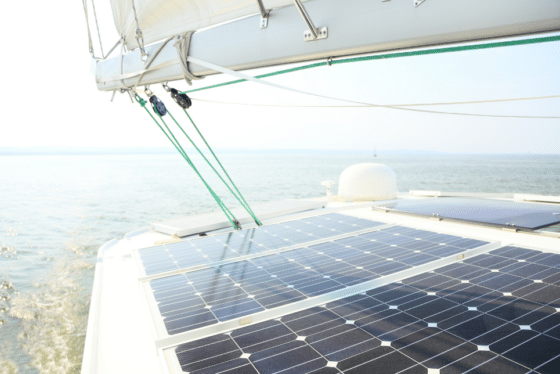
Looking for a way to power your devices on your pontoon boat, sailboat, or other vessels? One reliable way to keep your devices running is to invest in a solar battery charger for boats.
In this post, we will share some of the top solar battery chargers for boats with you. But first, let’s explain what a solar charger for a boat battery is and how it works. We will also go over important features to consider as you are comparing products.
What is a Solar Battery Charger for a Boat?
A solar battery charger consists of several components:
- Solar panels
- A charge controller
The job of the charger is to collect energy from the sun and transfer it to your batteries. That way, you can power your onboard devices using a renewable source of power.
Not only is a solar battery charger eco-friendly, but it is also economical on your boat. Popular Mechanics has called solar power the “cheapest electricity in history. ( 1 )”
How Does a Solar Charger for a Boat Battery Work?
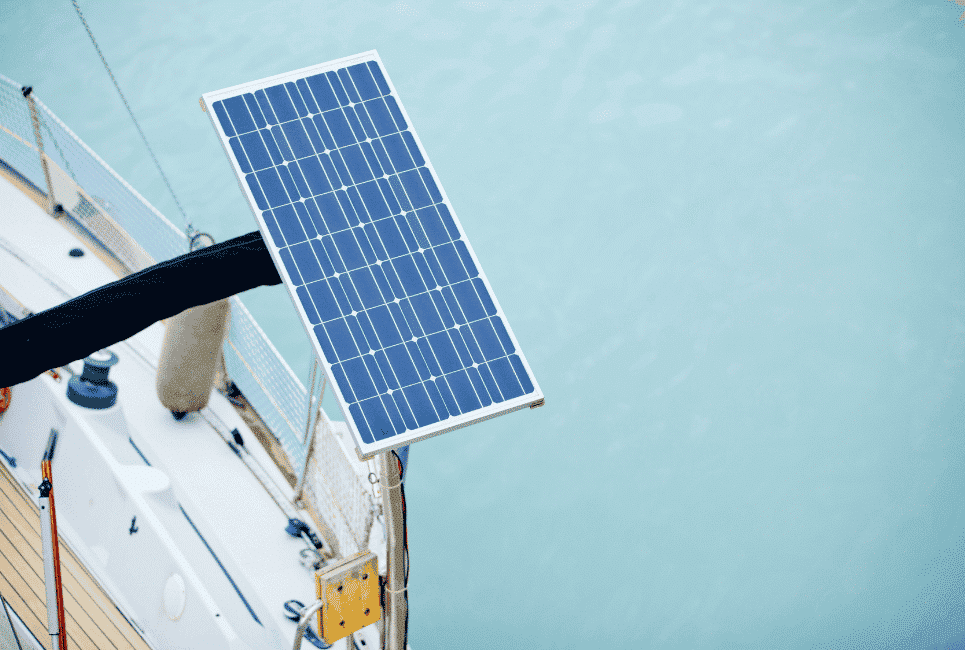
The way these chargers work is quite simple. Lifewire explains, “Solar battery chargers work by converting energy from the sun into electricity that can be stored in a battery. This is accomplished via a photovoltaic solar panel. ( 2 )”
Once the solar panels harvest the energy, the component called the charge controller regulates the power and distributes it to the battery bank .
Some systems do not include a charge controller, but you should get one that does. Otherwise, you will have to shop for a compatible charge controller separately.
Top Solar Battery Chargers for Boats
Best waterproof solar charger for boat battery.
SOLPERK 50W/12V Solar Panel Kit, Solar Battery Trickle Charger Maintainer + Waterproof Controller
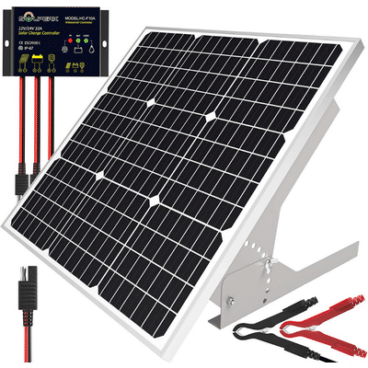
What we like
- The adjustable mounting.
- Installation is quick and easy.
- Great charging system.
What we don’t like
- Some people reported problems with the connectors.
The SOLPERK 50W/12V Solar Panel Kit is an excellent option for a portable solar charger for boats that features robust, waterproof construction.
What we love about this product is that it was engineered to survive regular exposure to stormy conditions. The anodized aluminum frame resists corrosion, and the solar panel features waterproof tempered glass. The charger regulator controller is enclosed in a protective waterproof case, so you can count on it to keep functioning on rough or rainy seas.
Key Specifications
- Monocrystalline silicon
- Up to 24% conversion rate
- 21.3” x 21.3” x 4.45”
- Includes solar panel, charger regulator controller, 2 alligator clips, 1 set of mounting pieces, 1 SAE extension cable
- The adjustable mounting bracket lets you rotate the panels up to 60 degrees. That way, you can get the best angle for the sun.
- Some SOLPERK products have issues involving battery overcharging, but the 50W/12V Solar Panel Kit seems to charge the battery reliably to the right level.
- There may be some quality control issues with the connectors. But most units are unaffected.
Best Compact Solar Battery Charger for Boats
Solar Power Bank, YELOMIN 20000mAh Portable Solar Charger, Waterproof Backup Battery Pack
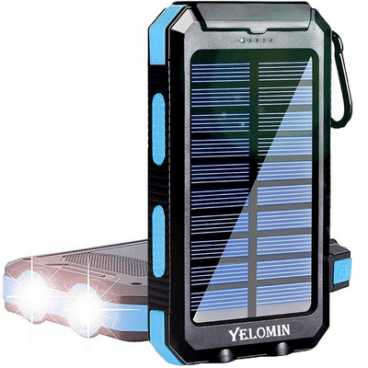
- Wide range of device compatibility .
- Surprisingly durable.
- A charging system-related manufacturing flaw reported in some units.
If you are looking for something incredibly compact you can use just to keep your mobile devices charged when you are in your kayak, jet ski, or other small vessels, you can consider the YELOMIN 20000mAh Portable Solar Charger.
- 5 volts output
- 2 USB outputs
- 19.00 centimeters x 10.50 centimeters x 3.00 centimeters
- Package includes a solar panel charger, USB cable, carabiner, and user manual
- This product is compatible with a wide range of devices.
- Even with its compact, lightweight design, this solar charger is surprisingly durable.
- Some purchasers complain that the solar charging feature does not work. This could be a manufacturing flaw in some units, but it could also be that they forgot to charge it via USB initially. Only after doing that twice does the solar charging function work.
Best MPPT Solar Battery Charger
20W 12V Solar Battery Charger, Waterproof 20 Watt 12 Volt Solar Panel Trickle Charger & Maintainer
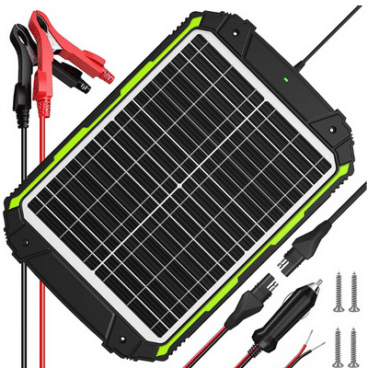
- Long-lasting construction.
- Easy setup.
- Charge-level LED indicator.
- Occasionally, packages arrive with a damaged charger.
Our top recommended marine solar battery charger featuring MPPT technology is this 20W 12V Solar Battery Charger. You can expect efficiency that is around 20-30% higher than what you would get if you went with a standard PWM solar charger for your boat.
- 18 volts operating power voltage
- 1.1 amps operating power current
- 20.15″ L * 13.78″ W * 0.7″ H
- Kit includes solar charger, battery clamp cable, bare wire cable, cigarette lighter cable, mount screws, and user manual
- You can tell the moment you handle it that this solar charging kit features robust construction and will be able to handle conditions at sea.
- Setting up this solar battery charger on your boat is ridiculously easy. It is just a matter of connecting the components and angling the panels. Not every solar charger includes multiple types of connections in the kit. This one does, so you should have exactly what you need to get started.
- Along with its high efficiency, this product boasts a three-stage charging algorithm for optimal performance.
- It is easy to see at a glance if your batteries are charged thanks to the LED indicator.
- This solar battery trickle charger usually works great. Occasionally a unit ships out that does not work at all. While this is rare, you should test your new charger out right away after receiving it.
Best Monocrystalline Solar Panel Battery Charger for Boats
VICEMOB 20 Watt 12 Volt Solar Battery Charger & Maintainer Kits
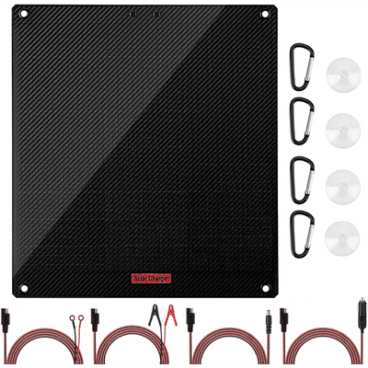
- Lightweight and easy to transport.
- Low maintenance.
- Fast charging on ideal conditions.
- Excellent connector quality.
- Life expectancy of 35 years.
- This unit occasionally ships improperly packaged.
Our top pick for a monocrystalline solar panel battery charger is the VICEMOB 20 Watt 12 Volt Solar Battery Charger & Maintainer Kit. This product’s expertly engineered panels feature solar cells sandwiched between EVA layers with ETFE film on top. The manufacturer states that you can expect up to 95% transmittance.
- 20 watts power output
- 18.2 volts operating power voltage
- 14” x 13.2”
- Multiple connector types included: cigarette adapter, battery clamps, ring connectors
- These solar panels are impressively lightweight and easy to transport, carry and install on your boat.
- The panels have a self-cleaning design, reducing the amount of maintenance they need on a regular basis.
- Living up to the promise of its high efficiency, this system charges rapidly in full sun.
- The quality of the connectors is impressive compared to those in competing products.
- While we can recommend this kit to beginners, it may just be the last one you ever need. With its durable construction, the expected lifespan of the product is up to 35 years.
- Sometimes this unit does not ship properly packed, and components might be damaged. Take a careful look when you receive your shipment.
Best Solar Battery Charger for Boats on Cloudy Days
ECO-WORTHY 12 Volt 10 Watt Solar Car Battery Charger & Maintainer
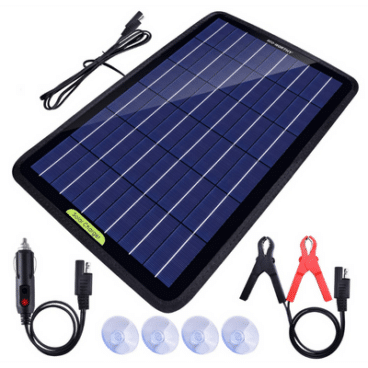
- Built-in diode feature.
- Simple installation.
- Robust materials.
- The waterproof feature has some drawbacks.
If you live in a climate with a lot of cloud cover, you might despair of finding a solar charger that will work in your area. But the ECO-WORTHY 12 Volt 10 Watt Solar Car Battery Charger & Maintainer can perform great even on days you do not get full sunlight. That said, you will see a boost of about 30% in power if you are operating in sunny conditions versus cloudy conditions.
- 14.37” x 1.46” x 9.25”
- Kit includes battery clips, PVC suckers, and cigarette light adapter
- One of the most exciting features this product boasts is a built-in diode. This feature prevents unwanted draining.
- Installing this charger is easy and intuitive.
- The materials are sturdy, and this product should stand the test of time.
- While you can use this product on your boat, be aware that it may not be as weatherproof as some other options on this list. You may need to take steps to improve its weather-resistance on your own.
Features of Solar Battery Charger Systems
What to consider before buying the best solar battery chargers for boats, battery type.
Types of solar battery chargers for boats include models for trickle, float, and boost batteries. The trickle batteries are most widespread. While they charge gradually, most users do not need the rapid charging enabled by the surge involved in boost chargers. If you want the functionality of a trickle charger with overcharge protection, consider a float charger.
Consider your options for the charger panel type. These include mono-crystalline, polycrystalline, and amorphous silicon panels. The mono-crystalline panels are very efficient with energy conversion. But you will pay less for polycrystalline panels. If you are boating in a cloudy climate, however, you should consider the amorphous silicon panels.
Make sure the voltage, watts, and amps for the product you are considering will be suited to your requirements.
Charge controller
As already mentioned, the charge controller is an important component in a solar battery charger. Make sure it is included with the system.
Self-regulation
While most solar chargers for boats feature built-in charge controllers, some do not. These models are known as “self-regulating” solar battery chargers.
MPPT vs. PWM
Your charge controller may feature pulse width modulation (PWM) or maximum power point tracking (MPPT) technology. PWM can regulate current, but not voltage. MPPT can regulate both. The upshot with MPPT is significantly higher efficiency.
Installation
Pay attention to how easy it is to install your charger. You may want to choose a product with more than one type of connector so that you have a variety of easy options.
Waterproofing
This feature will protect your charger from splashes and precipitation.
Construction
High-quality, durable materials will extend the lifespan of your charger.
Performance
The right model will provide you with rapid, efficient charging and deliver the power you need reliably.
CNET says that you can expect around 25-30 years of life out of solar panels ( 3 ). Some types of solar chargers may last even longer.
You might also be interested in:
- Best Depth Finder For Pontoon Boat in 2022
- Best Funny Boat Accessories
Frequently Asked Questions About Solar Battery Chargers for Boats
Yes, you can use a solar panel to keep your trolling motor battery pack charged.
You need to calculate how much power you intend to use on your boat. This will help you determine the battery capacity you need.
Connecting a solar system on a boat is a straightforward process. Begin by connecting the battery and controller. After that step is complete, you can connect the controller to your solar panel. When you mount the system, it should be in a horizontal configuration to maximize sun exposure while your boat is in motion.
Check the amp-hours for the battery. For every 100 amp-hours, you need about 3.5 watts.
Yes, it is fine to leave a solar battery charger on all the time. The charge controller will protect the battery. Indeed, this is even recommended if you are using lead-acid batteries. Doing so will help them last longer.
Electrical and Electronics Engineering graduate Kenneth Lundgren says, “You can get a lot more power from a given set of solar panels if you also have a battery, assuming you are not needing the power continuously. For instance, you can let the battery charge all day, maybe even several days, and it will supply much more power for an hour or two than the solar panels alone. (4)”

Troubleshooting Pontoon Boat Battery
Pontoon boats are a great way to enjoy the water and spend quality time with family and friends. But just like any other boat, they rely on a battery to power various systems, including navigation lights, trolling motors, and other…

Best Ice Fishing Fish Finders in 2023
In search of the best ice fishing fish finders in 2023? Not all fish finders are created equal, particularly when it comes to ice fishing. Specialized features are crucial to ensure successful outings in harsh winter conditions. You require a…

Best Side Imaging Fish Finders in 2023
Navigating the world of angling equipment can be challenging. That's especially true when it comes to side imaging fish finders, given the extensive range of options available in 2023. This post makes it easy for you to narrow down your…

How to Choose a Fishfinder for Your Boat: A Comprehensive Guide
Today, we embark on a journey to unravel the secrets of choosing the perfect fish finder for your boat. As we navigate through an ocean of options, we'll explore different types of fish finders, delve into their key features, and…
Accessories
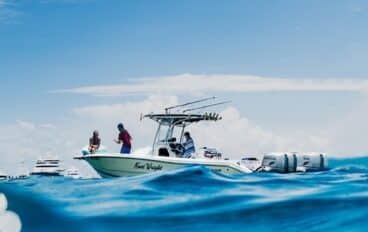
5 Best Portable Fish Finder in 2023
Looking for a portable fish finder for kayaking, ice fishing, or other activities? The good news is that there are a lot of solid products out there. The year 2023 has ushered in an array of advanced models, each brimming…
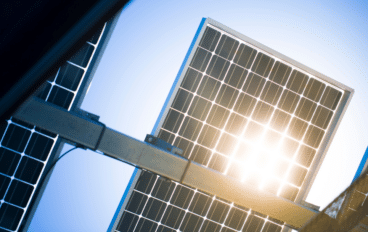
Charging Your Trolling Motor Battery with a Solar Panel
Charging your trolling motor battery with a solar panel is not just the right thing to do for the environment, it is extremely convenient. When you’re out on the boat, with any luck, you’ll have access to a good amount…
Don't miss out

6 Best Solar Chargers for Boat Batteries
Categories Boating
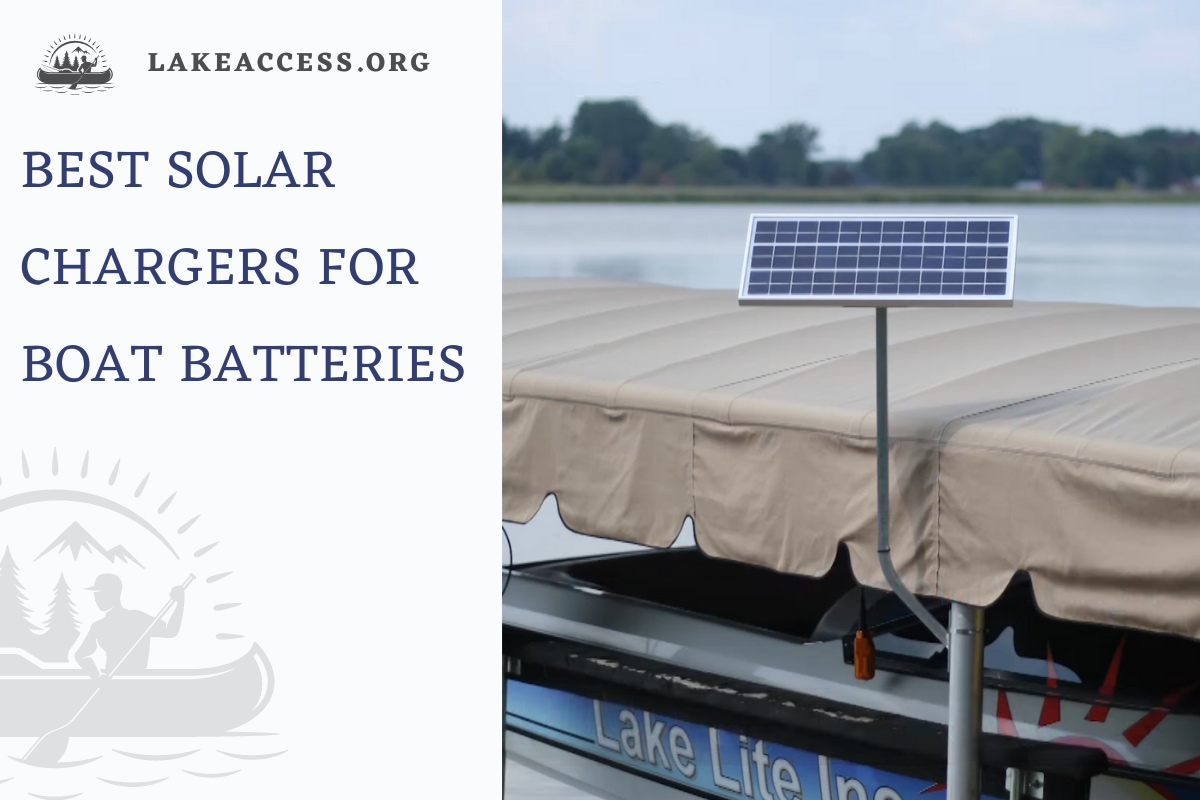
As an ardent boat lover, you understand the significance of maintaining a reliable power source for your boat battery. Now, imagine harnessing the unlimited energy of the sun to keep your boat’s battery continuously charged, virtually eliminating the inconvenience of a dead battery! This is the splendid promise of solar chargers for boat batteries. They provide an eco-friendly, sustainable, and infinitely renewable source of power, making them the ultimate solution for those long boat trips or for off-grid sailing adventures.
This guide explores the world of solar chargers for boat batteries, unearthing why you need one, the factors you should consider before purchasing, and recommending the best options available in the market today. Whether you’re a seasoned boater or a beginner, let’s embark on this informative journey toward clean, renewable marine energy!
1. Sunway Solar Battery Trickle Charger
Sunway Solar Battery Trickle Charger is a powerful and reliable device that helps keep your batteries charged and ready to go. Whether you need to keep your car battery charged while it’s parked or you want to maintain the charge on your RV or boat battery while in storage, this solar trickle charger can help.
The Sunway Solar Battery Trickle Charger is designed to be easy to use, with a simple plug-and-play setup that requires no special skills or knowledge. The device is equipped with a built-in solar panel that collects energy from the sun and converts it into a steady stream of electricity that is fed directly to your battery. Simply connect the charger to your battery and let it do its job.
Overall, the Sunway Solar Battery Trickle Charger is an excellent choice if you’re looking for a reliable and effective way to keep your batteries charged and ready to go. With its easy-to-use design, versatile compatibility, and durable construction, it’s the perfect solution for anyone who needs to maintain the charge on their batteries while on the go.
No products found.
2. SOLPERK Solar Panel Kit 20W 12V
If you are looking for a solar battery trickle charger maintainer that can keep your 12V batteries fully charged and protected, you might want to consider the SOLPERK Solar Panel Kit 20W 12V. This kit has three main components: a solar panel, a controller, and a mounting bracket. Let’s take a look at each of them.
The solar panel is the heart of the kit. It is made of high-quality monocrystalline cells that can convert sunlight into electric energy with high efficiency and durability. It has a power of 20 watts and a voltage of 12 volts, which means it can provide enough current to charge and maintain your batteries. The solar panel can work well even in low-light conditions, such as cloudy or rainy days.
The kit is very easy to install and use. You just need to connect the solar panel to the controller using the cable and then connect the controller with your battery using the alligator clips or the cigarette lighter plug. The kit has plug-and-play interfaces, and no extra maintenance is required. You can leave it on your vehicle and let it do its job.
3. SUPER POWER 12V Solar Battery Charger
Are you looking for a way to charge your 12V batteries or devices with solar energy? If so, you might want to check out the SUPER POWER 12V Solar Battery Charger. This is a portable and waterproof solar charger that can provide up to 10W of power from the sun. It has a built-in intelligent MPPT controller that optimizes the charging performance and protects your battery from overcharging or undercharging.
The SUPER POWER 12V Solar Battery Charger has many benefits that make it a great choice for your charging needs. It can save you money and energy by reducing your dependence on grid power and extending the lifespan of your battery. It can also reduce your carbon footprint and environmental impact by using renewable energy. It can also charge various types of 12V batteries or devices, such as cars, motorcycles, boats, RVs, trailers, gate openers, etc. You can use it in different scenarios, such as camping, fishing, hiking, or emergency.
The SUPER POWER 12V Solar Battery Charger is also durable and reliable. It is made of high-quality materials that can withstand harsh weather conditions. It has a waterproof and dustproof design that protects it from rain, snow, or dirt. It also has a sturdy and corrosion-resistant aluminum frame that supports the solar panel. It has a long service life and a low maintenance cost. It is also easy to use and monitor. It comes with an adjustable bracket and an SAE cable kit that make it easy to install and use. It also has an LED indicator that shows the charging status or power level of the solar panel or battery.
4. ECO-WORTHY Solar Charger
ECO-WORTHY Solar Charger is a compact and lightweight charging solution that harnesses the sun’s power to keep your devices up and ready to go. One of the best things about the ECO-WORTHY Solar Charger is how versatile it is. It features multiple charging ports, including USB and DC ports, so you can charge various devices like your smartphone, tablet, camera, and more. Plus, with its fast charging technology, you can even charge your devices in low light conditions, so you’re never left without power.
But what really sets the ECO-WORTHY Solar Charger apart is its eco-friendly design. By using solar power instead of traditional energy sources, you’re saving money on your electricity bills and doing your part to help the environment. And with its durable construction, this solar charger is built to withstand the rigors of outdoor use, so you can take it with you on all your adventures.
5. OYMSAE 20W 12V Solar Panel Battery Charger
The OYMSAE 20W 12V Solar Panel Battery Charger is a fantastic way to keep your batteries up and ready. Whether you’re out camping, traveling, or simply need a backup power source, this solar panel charger has got you covered.
Its high efficiency and reliability set the OYMSAE 20W 12V Solar Panel Battery Charger apart. With its advanced solar cells, this charger can convert sunlight into energy at a high rate, ensuring that your batteries get charged quickly and efficiently.
Another great feature of this solar panel charger is its versatility. It’s designed to work with a wide range of batteries, including car batteries, boat batteries, and RV batteries. And with its compact and lightweight design, you can take it with you on all your adventures without weighing you down.
Using the OYMSAE 20W 12V Solar Panel Battery Charger is also incredibly easy. Simply connect the charger to your battery and let the sun do the rest. Thanks to its ability to generate power even in cloudy weather, you can even use it in low-light conditions.
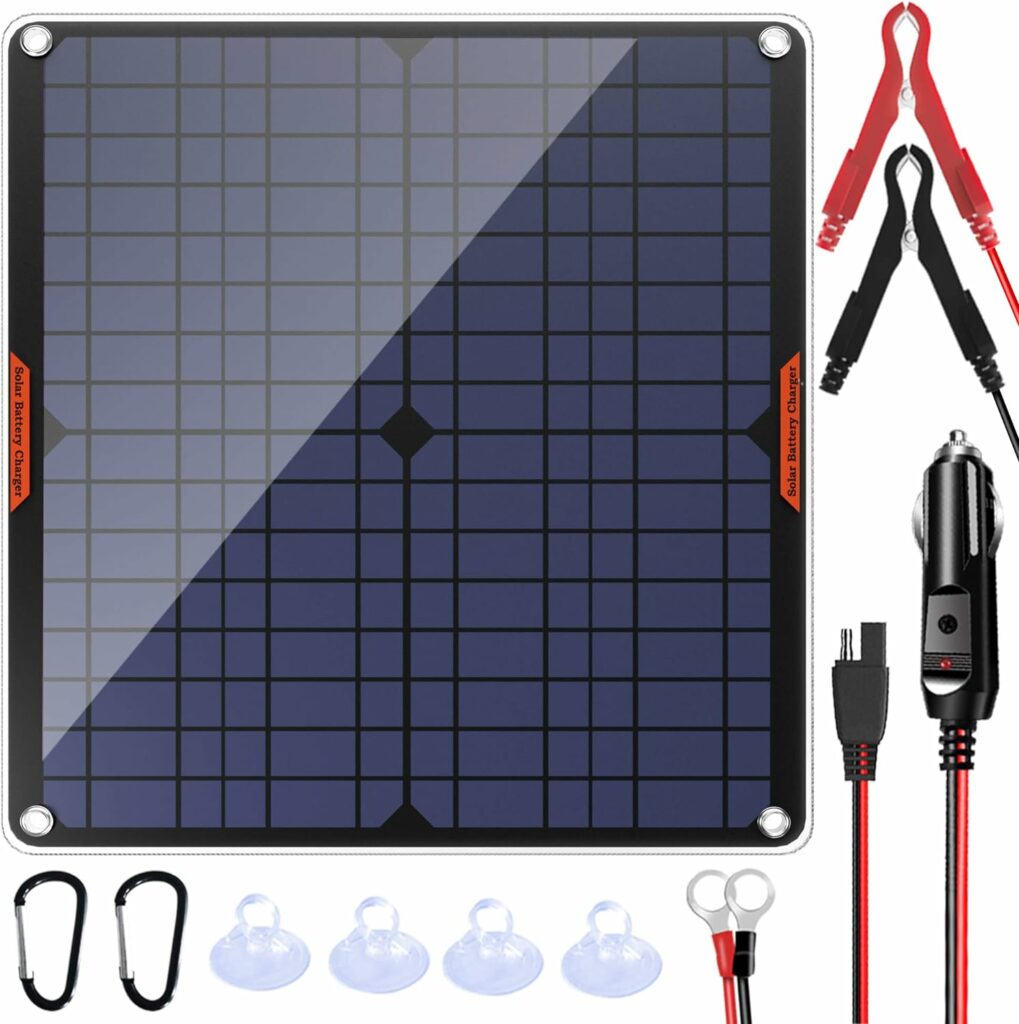
6. SUNER POWER 20W 12V Solar Battery Charger
The SUNER POWER 20W 12V Solar Battery Charger is a versatile and reliable solution for keeping your batteries charged up and ready to go, all thanks to the power of the sun. Whether you need to charge your boat, RV, or other 12V battery, this solar charger has got you covered.
One of the great features of the SUNER POWER 20W 12V Solar Battery Charger is its high conversion rate. It uses advanced solar cells that can convert sunlight into energy at a high rate, ensuring that your batteries get charged quickly and efficiently.
Another great thing about the SUNER POWER 20W 12V Solar Battery Charger is its durability. It’s built to withstand the elements and can be used in all weather conditions, making it perfect for outdoor use. It’s also lightweight and compact, so you can take it with you on all your adventures without weighing you down.
Factors to Consider When Choosing a Solar Charger
When choosing a solar charger, there are several factors to consider. Whether you’re using it for your boat batteries or any other application, selecting the correct solar charger is crucial for optimal performance and reliability. Here are some of the critical factors to keep in mind:
• Power Output: The power output of a solar charger is one of the most important factors to consider. It determines how quickly the charger can charge your batteries or devices. Make sure to choose a solar charger with a power output that is suitable for your needs.
• Portability: If you plan on using your solar charger while on the go, it’s essential to choose a portable and lightweight model. Consider the size and weight of the charger and any carrying cases or straps that may be included.
• Durability: A solar charger is an investment, so you’ll want to choose one that is built to last. Choose models that are built to endure severe weather and that use high-quality materials in their construction.
• Compatibility: Not all solar chargers are compatible with all devices or battery types. Be sure to check the charger’s specifications to ensure that it is compatible with your boat batteries or other devices.
• Charging Time: Solar chargers can take varying amounts of time to fully charge a battery, depending on factors such as the weather and the battery’s capacity. Consider how quickly you need your batteries charged, and choose a solar charger with a charging time that meets your needs.
• Price: Solar chargers can range in price from relatively inexpensive to quite costly. Consider your budget and choose a solar charger with the features and capabilities you need at a price that works for you.
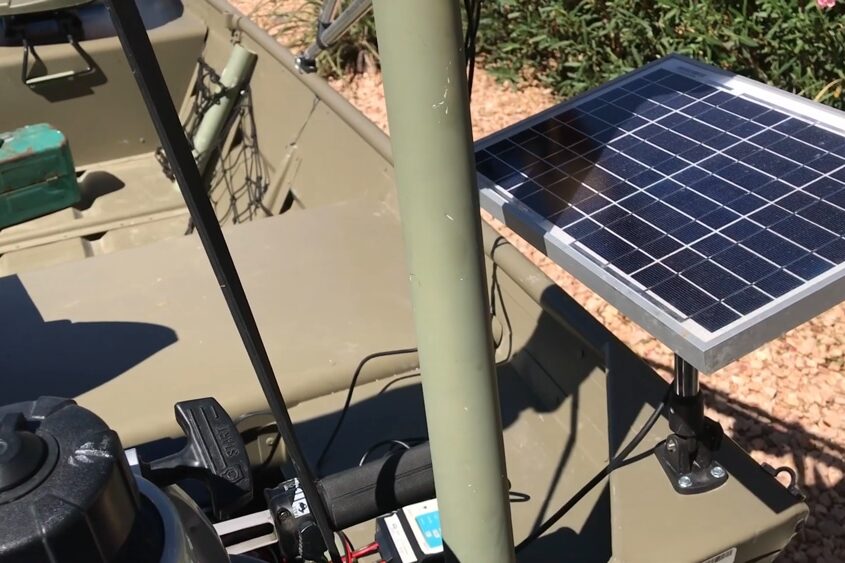
Installing a Marine Solar Battery Charger
Installing a solar battery charger is a relatively simple process that can be done in a few easy steps. Here’s a quick overview of how to install a solar battery charger:
- First, choose a location for your solar panel where it can get maximum exposure to sunlight. This could be on the roof of your RV or boat or the ground near your car. Ensure that the solar panel is installed in a secure location where it won’t be easily damaged.
- Next, mount the solar panel in the chosen location using brackets or screws. Ensure the solar panel is securely attached and won’t move or shift around.
- Once the solar panel is mounted, connect the wires to the charge controller. The charge controller regulates the flow of electricity from the solar panel to the battery and helps prevent overcharging or damage.
- Connect the battery to the charge controller using the provided cables. Make sure that the positive and negative terminals are connected correctly.
- Once everything is connected, test the system to ensure it works properly. Check the battery’s voltage and ensure it’s charging properly.
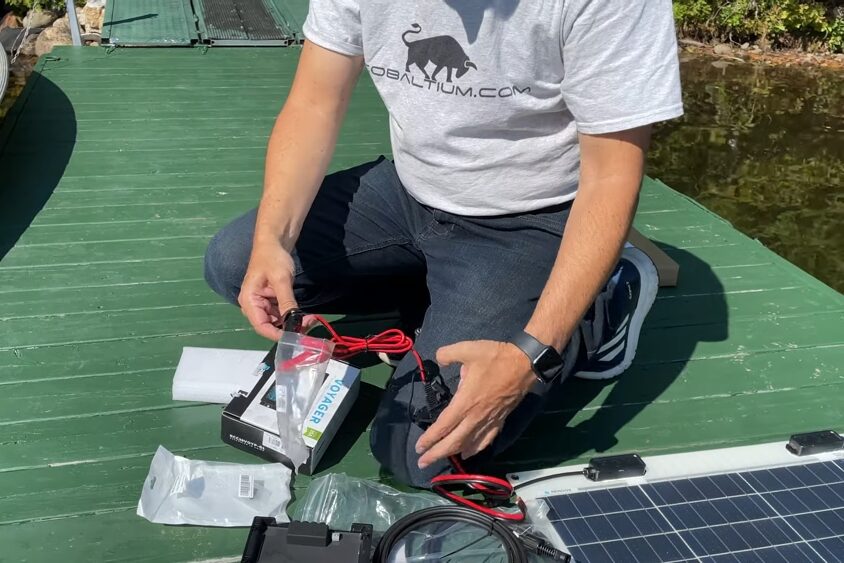
What are the benefits of using a solar charger for a boat battery?
Using a solar charger for a boat battery has several benefits. Firstly, it is an environmentally-friendly option as it harnesses the power of the sun to generate electricity, reducing the need for fossil fuels. Secondly, it is a portable and convenient option, allowing boat owners to charge their batteries while on the water without needing access to an external power source. Additionally, solar chargers can be cost-effective in the long run as they do not require any ongoing fuel costs or maintenance. Overall, using a solar charger for a boat battery can be a practical and sustainable solution for keeping your battery charged and ready to use.
Are there any cons to using a solar charger for a boat battery?
Solar chargers are generally a good option for charging boat batteries, but there are some potential drawbacks to consider. One is that solar chargers are weather-dependent, so they may not work as well on cloudy or overcast days. Additionally, they may have a lower charging speed compared to other types of chargers, which means it could take longer to fully charge your battery. Finally, solar chargers can be more expensive than other types of chargers, especially if you need a high-powered charger to keep a larger boat battery fully charged. Despite these potential drawbacks, many boat owners find that solar chargers are a convenient and eco-friendly way to keep their batteries charged while out on the water.
How do solar chargers work to charge boat batteries?
Solar chargers for boat batteries work by using a solar panel to convert sunlight into DC electricity, which is then regulated by a charge controller. The charge controller helps to ensure that the battery is charged properly and does not become overcharged or damaged. The electricity is then stored in the battery, which can be used to power various devices on the boat. Solar chargers are a great option for boat owners who want a portable and environmentally-friendly way to keep their batteries charged while on the water.
What is the difference between trickle chargers and standard solar chargers?
Trickle chargers are typically low-amperage chargers that are designed to slowly charge a battery over a long period of time. They are called “trickle” chargers because they deliver a small amount of current to the battery continuously, at a rate that is typically less than the battery’s self-discharge rate. This helps to keep the battery fully charged without overcharging it, which can be harmful to the battery.
On the other hand, standard solar chargers are designed to charge a battery using the power of the sun. They are typically more powerful than trickle chargers and can deliver a higher amperage to the battery, which allows them to charge the battery more quickly.
Which type of charger is better for long-term battery maintenance?
For long-term battery maintenance, a smart charger is generally considered to be the best option. Smart chargers use advanced technology to help ensure that your batteries are charged properly and maintained at an optimal level, which can help prolong their lifespan and prevent damage or overcharging.
One of the key features of smart chargers is their ability to monitor the battery’s voltage and adjust the charging rate accordingly. This helps prevent overcharging or undercharging, which can be harmful to the battery and shorten its lifespan.
🚚 FREE US SHIPPING ON ORDERS OVER $30 🚚

Soak up the Sun: The 5 Best Solar Battery Chargers for Boats

It's a tale as old as (modern) time. You're in the middle of a favorite show and you get that low-battery warning. We've all been there.
It's no fun when your electronic devices lose power. It's bad enough when you're at home and have to stay attached to the wall. It's a different story when you're off-the-grid and anchored out on your boat.
From chartplotters, GPS, VHF radios and cell phones to fish finders, stereos and blenders (can't leave out the blender), you need electronic devices on a boat for safety, information, entertainment and what-not. And that means a power source of some sort.
This is where solar panels and solar battery chargers for boats come into play.
Charging everything up at home or in the marina is always a great idea. But what if you're out on the high seas? Or high lake, for that matter.
Read on to find out how handy and efficient boat solar battery chargers can be.
What Is a Solar Battery Charger for a Boat?
A solar battery charger for a boat has two basic parts that work together. The solar panel collects energy from the sun. This energy then goes to the charge controller , which regulates, stores and distributes it.
All of that collected energy is then deposited into your battery bank (think of it as your very own bank teller, of sorts). Then, when you need it, you simply attach it to your electronic device.
If the battery is completely empty, the charge controller puts as much energy as possible into it until it reaches a full charge. At this point, it goes into float mode , which maintains the power level automatically.
The charge controller is a great piece of gear as it improves the charge quality and prevents the battery from overcharging and from loose connections.
From wind generators and solar panels to boat solar battery chargers, renewable energy is a free (after the initial purchase of the capturing equipment) and a smart way to go about boating.
Let's discuss more about solar battery chargers and how they can provide power and peace of mind for days (and nights) out on the sailboat, liveaboard trawler , pontoon boat or sport fishing boat. Even kayakers can benefit from small solar panel battery chargers.
Featured Boat Care Product
| keeps your painted or clean and shiny. |
Check Price on Amazon - Better Boat's deck cleaner is a non-slip formula designed to quickly and efficiently break down dirt and grime on fiberglass and painted decks. Pair it with deck brush heads and extension poles for an easy application.
Features of Solar Battery Charger Systems
Charge controller.
Also known as a regulator, the charge controller is what puts the energy into your battery. It's very possible to have a solar panel without one. But you'll want to make sure you choose a panel that comes with a charge controller.
Charge controllers are necessary if the panel is more than five watts. The best thing about the charge controller is that it can store the energy for later use. A solar panel alone needs sunlight to work.
Solar Panels
The solar panel is the part that collects the energy from the sun. You've likely seen them on house rooftops. They're becoming more and more prevalent on boats.
Pulse Width Modulation
Pulse width modulation (PWM) is the temperature compensation that protects the battery from things like overcharging and frequent charging. This is a must-have safety and efficiency feature. You don't want to have to go out and buy new batteries every Monday.
Self-regulation
Self-regulating boat solar battery chargers don't have a built-in controller. Every boater is different, of course, but anything built-in is a positive feature in my opinion.
Plastic and Aluminum Construction
Plastic and aluminum mean less breakage and more weather resistance. Wind, sun and saltwater (and water in general) can be rough on any piece of boating gear as well as anchors , ratchet straps and dock lines .
Types of Solar Battery Chargers for Boats
- Boost Charging provides a high current for a short time to fully charge the battery
- Trickle Chargers provide a very low level of output by continuously releasing a small amount of power to charge the battery as you use it
- Float Chargers are similar to the trickle charger, but they prevent overcharging (this type is my pick for the best all-around solar battery charger)
The 5 Best Solar Battery Chargers for Boats
So, we've come to the conclusion that solar battery chargers are a great investment for liveaboards, recreational boat and even fishing kayaks and jet skis.
Let's take a look at some examples for purchasing options.
1. Eco Worthy Portable Folding Solar Charger and Panel
|
|
The Eco Worthy Folding Solar Panel comes pre-wired and pre-installed with a 15 Amp PWM solar charge controller that protects from overcharging and reverse connections. The high-efficiency monocrystalline solar cell is made of lightweight aluminum .
Its suitcase-style design makes it easy to transport . When you get where you're going, just unfold and set it up.
The charge controller has waterproof integrated junction boxes , and there's a corrosion-resistant frame on the panel.
This is a nice mid-sized panel and solar battery charger. Best part? All that pre-wiring and pre-installing makes it ready to use right out of the box .
- Size : 30.7" x 22.1" x 5.1"
- Charger Type : Float Charger
- Panel Type : Monocrystalline
2. HQST Solar Battery Charger and Panel
|
|
The HQST provides quiet power production for 12 and 24-volts in marine and other outdoor and off-the-grid environments. It has a 30A PWM LCD charge controller with LCD display, 20-foot adapter cables and a set of Z-brackets for mounting.
It can charge a 50Ah battery from 50% in three hours (depending on the sunlight, of course). Pre-drilled holes make the panel easy to install. You can expand your solar system by connecting other panels for even more energy output.
- Size : 40" x 27" x 1.5"
- Charger Type : Trickle Charger
- Panel Type : Polycrystalline
3. POWISER Solar Battery Charger and Panel
The POWISER 3.3W is an easy-to-connect and use trickle charger . It has polycrystalline high-efficiency solar cells with thin amorphous panels that allow it to be used in any weather.
Compact in size, it's perfect for jet skis and small boats . It even comes with suction cups to attach to your boat's window . I really like the compact size and shape of this solar panel and battery charger.
- Size : 14" x 8.5" x 0.8"
4. SOLPERK 12V Solar Battery Charger and Panel
The SOLPERK 12V Solar Panel is a trickle charger. It charges and maintains 12V batteries like Wet, Gel, MF and many more. The automatic charging and maintenance controller provides protection against short circuits, open circuits, reverse and overcharging.
It's lightweight and easy to install on jet skis and small boats . The best thing about the SOLPERK? It has thin film amorphous solar cells that allow it to work on cloudy days. Win/Win!
- Size : 21.3" x 18.2" x 1.2"
- Panel Type : Amorphous solar cells
5. Sunway Solar Solar Battery Charger
Small and compact, the Sunway Solar Battery Trickle Charger slowly charges and maintains battery power levels in Wet, Gel, Deep Cycle and AGM batteries. A built-in diode protects against reverse charging.
Crystalline panels have clear PV glass and ABS plastic housing for efficiency and durability. The long rectangular shape of the Sunway makes it a good choice for mounting on a dash or bow of the boat.
The charger maintainer has a cigarette lighter adapter and alligator battery terminal clips .
- Size : 13.9" x 0.5" x 5"
- Panel Type : Crystalline
Cleaning Solar Panels
As with any boating accessory, cleaning and general maintenance are needed for solar panels. Luckily, it's not too hard. Rainfall is a handy thing to have in this case. For more in-depth cleaning, here are a few tips.
- Use a soft brush to swipe away any caked-on dirt, grime and the inevitable bird droppings. You may need an extension rod for this job.
- Next, get out that garden hose and spray away. A boat hose nozzle with an adjustable water stream is an excellent tool to have. You don't want to shoot your panels with a heavy stream of water.
- A microfiber sponge or cloth is helpful if there are still stains and dirt to scrap away.
- Using soap is not suggested as it can leave a residue that will attract dirt. Try a small amount of Better Boat Boat Soap to see how it does with your particular solar panels. It's 100% biodegradable and designed to rinse clean and residue free.
As you can see, you have a lot of choices when it comes to keeping batteries charged out on the water. Hopefully, this has shed some light (pun intended) on your boat solar battery charger questions.
May the wind be at your back and your batteries always be full.

- choosing a selection results in a full page refresh
Questions? Call Us Today:
Monday - Thursday: 10am - 5:30pm EST Friday: 10am - 1pm EST
- Get Free Proposal
- Lite Power Kits
- Remote Power Kits
- Off-Grid Power Kits
- Hybrid Power Kits
- Microinverter Kits
- All Solar Kits
- DELTA 1800 [Hot]
- DELTA MAX 2
- DELTA PRO [Best Seller]
- DELTA PRO 3 [New Release]
- DELTA PRO ULTRA
- C800X [New Release]
- F3800 [Best Seller]
- FORCE 15K ESS [New Release]
- All Solar Generator Kits
- All Solar Panels
- Solar Panels by Pallet
- Used Solar Panels
- Monocrystalline Solar Panels
- Polycrystalline Solar Panels
- Portable Solar Panels
- Flexible Solar Panels
- Bifacial Solar Panels
- 100 Watt Solar Panels
- 200 Watt Solar Panels
- 300 Watt Solar Panels
- 400 Watt Solar Panels
- 500 Watt Solar Panels
- Cabling & Wire
- Battery Chargers
- Bus Bars, Fuses, and Connectors
- Bluetti Accessories
- EcoFlow Accessories
- EMP Shields & Faraday Bags
- Solar Generator Covers
- Transfer Switches
- Wind Generators
- All Batteries
- Server Rack
- Used Batteries
- All Inverters
- Microinverters
- Ground Mounts
- Pole Mounts
- CRX Carport
- Mini Splits
- Portable AC & Fans
- Solar Refrigerators
- All Appliances
- EMP Protection
- Prepper Supplies
- Installer Tools
- Used Inventory
- Weekly Flyer
- New Arrivals
- Mini Course
- Find My Kit
Cart (0 item)
Your cart is empty
Charging Your Batteries on Open Water – The Best Solar Battery Chargers for Boats

Short on Time? Here’s The Article Summary
This article discusses the importance of having the ability to charge your boat's batteries and power electronic devices while on open water, highlighting the usefulness of solar electricity for boaters. It mentions that modern solar panels, inverters, and batteries are efficient, lightweight, and affordable, making them popular among recreational sailors and boaters.
The article also provides information on some of the best boat-friendly solar chargers and solar panel kits available, emphasizing their performance, affordability, and boat-friendly features. Additionally, it explains how solar battery chargers work, their benefits, and the components needed for a full solar power system on a boat. The article concludes by recommending specific solar battery chargers and other solar components for boats and encourages boaters to embrace solar power for their electricity needs while on the water.
Introduction
Making sure you have the ability to charge your electronic devices while you are away from land can be a difficult task. Having the ability to charge your boat’s batteries and power your electronic devices while you are on open water is also incredibly important, especially from a safety perspective.
This is where solar electricity comes in handy. Today, solar panels, solar inverters, and solar batteries are more efficient, lightweight, and affordable than they have ever been before. This is why they are becoming so popular with recreational sailors and boaters.
Not only can solar panels give you access to limitless source of renewable energy, you can now find modern solar accessories that are waterproof and completely practical for boaters.
How Can We Help?
If you are interested in investing in a solar power system for you boat, we are here to help. Knowing what you need and which products to choose can be somewhat overwhelming, which is why we are going to go over some of the best boat-friendly solar chargers and solar panel kits on the market today.
In addition to highlighting some of the best solar battery chargers for boaters, we will also explain some of the components you will need if you are looking to assemble a full solar power system for your boat.
Each of the products we have chosen to highlight was selected because they find the perfect balance between performance and affordability. They were also chosen because they have boat-friendly features, like water resistance, convenient carrying handles, and lightweight designs.
How are Solar Battery Chargers Useful for Boaters?
You might be wondering what a solar battery charger is and why you would need one for your boat, which is why we are going to quickly explain what they do and how they can be useful.
In simple terms, solar battery chargers use solar panels to absorb energy from the sun and turn it into useable electricity. The energy your solar panels collect then flows into a charge controller, which is a convenient device that can store and distribute that electricity as you require.
While some charge controllers contain built-in batteries, many boaters also invest in a separate high-capacity battery bank, which can store a greater amount of this solar electricity.
If you are wondering what you can use this newly collected solar electricity for, the answer is just about anything. While some will keep a solar battery charger and a set of portable solar panels on board in case of emergencies, or simply to charge their boat’s battery in the event it completely drains while away from land, others will use them simply to charge their portable electronics.
In either case, being able to access a limitless source electricity while you are on the water and far away from the plug-in outlets found at a marina is incredibly convenient.
The way you use your solar charger and the other components of your solar power system is up to you. Whether you want to stow a small solar charger away for emergencies, or you own a larger boat and want to assemble a more permanent solar power system, we can help point you in the direction of some high-quality products.
Stop worrying about draining your batteries while you are away from land and embrace solar power today!
The Best Solar Battery Chargers for Boats
The following portable solar battery chargers were selected because they are perfect for boaters. While they are also enjoyed by RV drivers and camping enthusiasts, the fact that they are versatile and highly portable also makes them the perfect solar accessory for any boat owner.
- MaxOak - EB150 Bluetti 1,500wh Portable Solar Power Station

While those that are new to solar electricity might not recognize the Bluetti EB150, it is actually one of the best-selling solar generators on the market. With a built-in LG 1,500wh lithium-ion battery and a fully integrated 1,000W power inverter, this is the perfect portable power station for any boater.
If you need to charge your battery, this highly efficient solar generator can easily pair with your choice of solar panels to give your boat’s battery the charge it needs. When it is not being used as a battery charger, it has the versatility to act as an emissions-free generator, which, thanks to a variety of output ports, can be used to charge and power just about any type of electronic device.
The EB150 can support a wide variety of plug-in devices thanks to the following output ports:
- 2 x Standard (wall-style) AC outports
- 4 x USB plug-ins
- 1 x USB-C plug-in
- 1 x 12V outlet
Even if you are just looking for a way to charge your smartphone and portable GPS device while you are away from land, the EB150 can charge these devices nearly 130 times on a single charge.
Boaters that are concerned about weight will appreciate the lightweight design and built-in carrying handle. At just 39.9 lbs, the unit is portable enough that you can easily carry it on and off your boat at your convenience.
The built-in LCD display screen and the ability to charge the internal battery with a standard AC wall input are added bonuses.
Key Features:
- Extremely safe built-in Battery Management System
- Highly efficient built-in MPPT charge controller
- Backlit LCD screen displays charge and discharge information, as well as the ongoing status of the battery
- EcoFlow - Delta 1,300wh Portable Solar Charger and Generator

The EcoFlow Delta 1,300wh solar generator is another perfect choice for those that are looking to take advantage of solar electricity on their boat. The internal lithium-ion battery is powerful enough to power everything from fridges to laptops and it works flawlessly as a battery charger in emergency situations.
It features a built-in 1,800W pure sign inverter , so the energy your solar panels collect can be used safely and efficiently. What we liked most about this unit is its fast-charging capabilities. Given that it can go from fully drained to 80% charged in as little as one hour, it is perfect for those that are looking for a quick and efficient charger.
The LED display screen provides charge input and output information, as well as the remaining battery life. It also comes with an 11’ XT60 to MC4 solar panel extension cable, so you can position your solar panels in the optimal position, while keeping the charger near your boat’s battery.
Like the EB150, the Delta has versatile output options, including multiple AC wall outlets, USB ports, and a 12V outlet, which can be used to charge small appliances, like fridges and coffee machines.
- Built-in MPPT charge controller for efficiency and battery protection
- 1 year shelf life is ideal for those looking for a battery charger they can use for emergency situations
- Chaining capabilities, meaning you can connect more than one unit for additional power
Additional Solar Components for Your Boat
While a solar power battery charger can be one of the most convenient pieces of solar equipment you can use on a boat, there are other pieces of solar power equipment you will need, especially if you are looking to build an entire solar power system for your boat.
Battery Banks
We strongly recommend investing in a battery bank to store the solar electricity your solar panels are able to collect. If you have a larger boat, especially one that has a kitchen below deck, your electricity demands can be quite significant.

If you have already purchased a set of solar panels and an inverter, consider a Lion Energy Solar Battery . We carry numerous Lion Energy batteries in a variety of sizes, so you will be able to find the perfect storage solution for your solar setup.
If you are a beginner, we strongly recommend taking a look at this Lion Energy 400W Solar Panel Starter Kit , as it is a complete kit that contains everything you need to get started. In one convenient package, you get a foldable solar panel, a power inverter, battery bank, and all of the cables you need to get started.
Solar Inverters
If you are looking to use solar energy to power appliances, or your boat has significant power needs, you may want to look into a solar inverter. A solar inverter will allow you to turn the DC power your panels collect into usable AC power, like you would access through your home’s wall outlets.

Browse our collection of high-quality Solar Power Inverters to find exactly what you are looking for. We carry solar inverters from all of the top brands, including Go Power, AIMS Power, Outback Power, and more.
Solar Panels
If you are just getting started with solar power, or you looking for an affordable option you can leave on your boat, we recommend taking a look at some of the affordable, reliable, and efficient products Renogy has to offer.

Everything from there foldable and water-resistant solar panels, to their highly portable, lightweight deep cycle solar batteries can be found by searching through our Renogy Collection . Here you will be able to find flexible solar panels, water-proof charge controllers, and even convenient battery monitors.
Final Words
As always, if you have any questions about solar battery chargers for boats, or any other questions about how you can take advantage of solar electricity while you are on the water, do not hesitate to reach out to us!
The Ultimate Solar + Storage Blueprint (Mini Course)
Struggling to understand how solar + storage systems actually work? Looking to build or buy your own solar power system one day but not sure what you need? Just looking to learn more about solar, batteries and electricity?
Join 15,000+ solar enthusiasts breaking free from their energy dependence with this short step-by-step video course that will make you a solar + storage expert. Start your journey to energy independence today.
Learn More Now

Who is ShopSolar.com?
ShopSolar.com is the #1 digital platform that enables consumers & businesses to source and purchase complete solar + storage solutions direct, saving you thousands in time, energy and money! With over 40,000+ happy customers, we’re on a mission to make solar simple, transparent and affordable.
Alex is a co-founder of Shop Solar, a company that he established in 2018 to revolutionize the solar industry by simplifying the process and making it more simple and cost-effective. Under his strategic leadership, Shop Solar has grown into a comprehensive one-stop-shop, empowering over 40,000+ customers to access top-quality solar and storage solutions, comprehensive information, intuitive tools, and professional installation services.
With a passion for innovation and sustainable energy, Alex has successfully expanded the business's reach and impact, serving as a driving force in the company's growth and development. You can browse best seller's here .
Leave a comment
Comments must be approved before appearing
* Required fields
Ed's Journey to Cutting His Electricity Bill by 50%
Patriot power generator 2000x review: the truth about the new 4patriots generator, 3 tips for maximizing your solar battery life, get a complimentary solar proposal today.
$150 Value - Free Offer (Limited Time Only!) No Strings Attached. Totally Free. Takes Less than 2 Minutes.
Added to your cart:
The Ultimate Guide to Solar Battery Chargers for Boats
In the quest for sustainable energy solutions, solar battery chargers for boats have sailed to the forefront. Utilizing the limitless power of the sun, these chargers not only keep your boat’s batteries topped up but also contribute to a cleaner, greener boating experience. This guide will navigate you through the many facets of solar battery chargers, from their practical benefits to tips on choosing and maintaining the right system for your needs.
What Is a Solar Battery Charger for Boats?
A solar battery charger is a device that uses solar energy to recharge the batteries on your boat. It works by converting sunlight into electrical energy, which is then used to replenish your battery’s power. Unlike traditional battery chargers that rely on shore power or a generator, solar battery chargers harness the power of the sun to keep your batteries charged, making them an eco-friendly and convenient solution for maintaining power while you’re out at sea.
Why Use a Solar Battery Charger on Your Boat?
Environmental Friendliness: Solar battery chargers use renewable energy from the sun. This makes them an environmentally friendly choice for boaters who want to reduce their impact on the environment.
Cost-Efficiency: Once installed, solar battery chargers can save you money in the long run. You won’t need to purchase fuel for a generator or pay for dockside power. Plus, solar energy is free!
Reliability: Solar battery chargers provide a steady source of power as long as there is sunlight. This can be particularly valuable on extended trips or during emergencies when you might need a reliable power source.
Low Maintenance: Solar battery chargers require minimal maintenance. They have no moving parts and are designed to withstand harsh marine environments, making them a durable choice for boaters.
How Does a Solar Battery Charger Work?
Solar battery chargers consist of a few key components: solar panels, a charge controller, and sometimes an inverter.
The solar panels are responsible for capturing sunlight and converting it into direct current (DC) electricity. The efficiency of these panels can vary based on their type, size, and the amount of sunlight they receive.
The charge controller is a crucial component that regulates the flow of electricity from the solar panels to the battery. It prevents overcharging by controlling the voltage and current, thus protecting the battery and extending its lifespan.
In some setups, an inverter may be included to convert the DC electricity from the solar panels or battery into alternating current (AC). This is particularly useful if you need to power AC appliances on your boat, though it is not always necessary for every setup.
Choosing the Right Solar Battery Charger
When selecting a solar battery charger for your boat, there are a few factors to consider to ensure you get the best system for your needs.
First, assess your power requirements. Determine how much power you need based on the size of your boat and the number of electrical devices you use. This will help you choose the right size and number of solar panels.
Next, consider the type of solar panels. Monocrystalline panels are often preferred for their high efficiency and compact size, while polycrystalline panels are slightly less efficient but more affordable. Thin-film panels are another option but may require more space and are generally less efficient.
The charge controller is another important consideration. Choose one that matches the output of your solar panels and the voltage of your battery. Look for features such as multi-stage charging and temperature compensation to optimize performance and battery health.
Additionally, think about installation space on your boat. Ensure you have enough room to mount the solar panels and that they will receive adequate sunlight exposure. The panels should be installed securely and positioned to maximize their exposure to the sun.
Lastly, durability is key. Ensure the solar panels and other components are designed for marine use, meaning they should be waterproof, corrosion-resistant, and capable of withstanding harsh marine conditions.
Maintenance and Lifespan
Maintaining your solar battery charger is relatively straightforward. Regularly clean the solar panels with a soft cloth and mild soap to remove dust and debris that can block sunlight. Check the connections and wiring to ensure there are no loose or corroded parts.
The lifespan of a solar battery charger depends on the quality of the panels and the conditions they are exposed to. High-quality panels can last 20 to 25 years, while cheaper alternatives may have a shorter lifespan. Investing in a well-made charger will provide you with reliable service for many years.
Upgrade Your Boat Battery to Lithium for Superior Performance
Upgrading your boat's battery to a lithium-ion model offers cutting-edge technology with significant advantages over traditional lead-acid batteries. Lithium batteries deliver higher energy density, meaning more power in a lighter, more compact form. They charge faster, last longer, and maintain consistent voltage output, all while being maintenance-free.
Although the initial cost is higher, the long-term benefits in performance, efficiency, and reduced weight make lithium batteries a smart investment for modern marine use. If you want to find top-quality lithium batteries, explore WEIZE for better performance.
With their ability to provide a reliable and eco-friendly power solution, solar battery chargers are revolutionizing marine technology. By integrating a solar battery charger into your boat, you not only contribute to a cleaner environment but also enhance your on-water adventures with a dependable and cost-effective energy source.
RELATED ARTICLES

Winterizing Your Golf Cart Batteries: Tips for Long-Lasting Performance

5 Warning Signs It's Time to Replace Your Golf Cart Battery

Will a 100Ah Battery Provide Enough Power for a Golf Cart?

How Many Batteries Does Your Golf Cart Require?

Car Battery Voltage: Everything You Should Know

How Should You Clean and Prevent Car Battery Corrosion?

Car Battery Sizes Explained: Why Size Matters

Exploring Car Battery Types: Insights and Tips

How Do You Properly Test a Car Battery with a Multimeter?

Are Car Batteries Universal? Find Out Here!

Essential Tips for Storing Your Car Battery When It's Not in Use

How to Safely Disconnect Your Car Battery

Car Battery Disposal: What You Need to Know

Your Car Battery Drains Overnight? Here's How to Fix It

Will Your Electric Car Last Longer Than a Traditional Gas Car?

Can You Put a Marine Battery in Your Car?

How Long Can Your Car Battery Last When Not in Use?

When Does Your Car Battery Need a Replacement?

5 Reasons Your Battery Dies and How to Stop It

Car Battery Dead? 8 Signs to Identify and What to Do Next

How Long Will It Take to Charge Your Car Battery While Driving?

Golf Cart Battery Maintenance Made Easy: A Complete Guide

How to Size Your Off-Grid Solar Power System

The Complete Guide to RV Solar Systems with Batteries

How To Hook Up Solar Panels To RV Batteries: A Practical Guide

How Do You Effectively Add Batteries to Your Solar Energy System?

Can Battery Storage Work Without Solar Panels?

Are Lithium Solar Batteries the Top Choice for Solar Panels?

How Long Do Solar Batteries Typically Last?

How to Tell If a Deep Cycle Battery Is Bad – Essential Guide

Are Solar Batteries Worth It? A Detailed Guide

Marine Batteries vs. Deep Cycle Batteries: Key Differences Explained

Deep Cycle Batteries: Everything You Need to Learn

Can Your RV Batteries Last Through the Night?

Charging LiFePO4 Battery Effectively and Safely

Batteries Advance: Lithium-Ion Deep Cycle Batteries

Lithium Battery Gets Wet: Hazards and Precautions

12V Battery: Which Type is Your Best Choice?

How to Dispose of Lithium Batteries

Are Lithium Batteries Worth It for RVs?

How do l size a LiFePO4 Lithium battery bank for my system?

Voltage Explained: A Beginner's Guide

Powering Your Adventures: A Guide to Lead-Acid and Lithium-Ion RV Batteries

A Step-by-Step Guide to Building Your Own Off-Grid Solar Power System

Long-lasting, Versatile Lithium Batteries: The Future of Power

WEIZE SLA Battery - The Epitome of Deep Cycle AGM VRLA Technology

Why is Lithium-iron-phosphate battery the best choice?
- Choosing a selection results in a full page refresh.

Let customers speak for us
WEIZE 12V 200W Solar Panel Starter Kit
Received as scheduled, installed but not tried. Having some fiberglass repair so not tried yet. Battery looks good and received fully charged at 12.7 volts.
Service was good, nicely packaged. I cannot rate the battery yet, I mean, give me this survey a year from now and I’ll telly you more.
SO FAR WORKS AS INTENDED, THANK YOU FOR A GOOD PRODUCT
The battery has performed as described and expected in its first 10 days. I would like any other formal information available to you comparing AGM technology to standard lead-acid batteries. I look forward to getting 6 years out of this battery, as I did with my Champion. Thank you

- Who Are We?
- Our Mission
- Schedule a Free Consultation
Best Solar Battery Chargers for Boats
Disclosure: Please be aware that some of the links in this post are affiliate links, and I may receive a commission if you make a purchase using those links. However, I only recommend products or services that I personally use or believe will be valuable to my readers. Affiliate links are a way for me to earn a small commission and keep providing you with high-quality content. If you have any questions or concerns, please feel free to contact me at [email protected] . Thank you for your support!
Boats and the open water can bring so much fun and relaxation. But keeping your boat’s battery charged shouldn’t be a hassle. That’s where solar battery chargers for boats come in handy. Harnessing the power of the sun, these chargers keep your boat’s battery topped up and ready for your next adventure.
You might think, “Why should I choose a solar charger for my boat?” The answer is simple. By using solar energy, you avoid wasting fuel on charging your battery. You’ll also save money on electricity costs and reduce your carbon footprint. It’s a win-win situation for you and the environment.
When you start shopping for a solar battery charger, know what to look for. The size, power output, and ease of installation are key points to consider. A good charger should provide enough power to meet your boat’s needs, be simple to install, and suit the available space on your boat.
With that in mind, we set sail on a journey to find the best solar battery chargers for boats, so you don’t have to. Now let’s dive into some top contenders.
We’ve compiled a list of top solar battery chargers for your boat. Dive in!
SUNER POWER 20W Solar Battery Charger

You should definitely consider this charger for maintaining boat batteries with its efficient and clever design.
- Portable and versatile
- Efficient MPPT controller
- Waterproof and durable
- May drain battery in cloudy conditions
- Not for heavy usage
- Some long-term reliability concerns
Heading out on a boat trip, you want your batteries in top shape. That’s where the SUNER POWER 20W Solar Battery Charger steps in. This portable, lightweight solar charger turns sunlight into electricity to keep your boat’s battery charged and maintained all year round.
The smart MPPT controller ensures efficient charging, generating 20%-30% more power than other models. It also has a 3-stage charging algorithm that keeps your battery safe from overcharging and short circuits. The color LED indicator visually displays the working status of the charger, which cuts off automatically when the battery is full – perfect for hassle-free, hands-off operation.
Built to withstand harsh weather, this solar charger combines high-strength glass and a durable ABS frame, ensuring it can handle storms and rough seas. The kit includes 3 SAE cable connectors, making setup a breeze. Just plug and play!
There are a few downsides to be aware of, however. In cloudy conditions, this charger may drain your battery, and it’s not suitable for heavy usage. Some users have also raised concerns about long-term reliability.
In summary, SUNER POWER’s solar charger serves as a great addition to your boat, keeping your batteries charged and maintained throughout the year. Just bear in mind its limitations and monitor its performance for the best results.
OYMSAE 30W Solar Trickle Charger

A handy solar charger that keeps your boat’s battery juiced up, but may not reach full charge.
- High 22% conversion rate
- Intelligent protection
- Charging visualization
- May not fully charge battery
- Suction cups weak in sun
- Limited for novice users
We recently tried the OYMSAE 30W Solar Trickle Charger and came away mostly impressed. This solar charger is perfect for maintaining a boat’s battery, especially if you’re out on the water for extended periods. With a 22% high conversion rate, the monocrystalline solar charger does an efficient job of gathering sunlight and converting it into power.
The built-in intelligent protection safeguards your battery against overcharging or reverse discharge. We appreciated the charging visualization, which includes indicator lights that show the different charging stages. This feature helps users understand if the charging process is working effectively.
However, some users might experience difficulty in achieving a full battery charge with this product. Apart from that, the included suction cups might not hold up well under constant sun exposure, so additional mounting might be necessary.
Overall, the OYMSAE 30W Solar Trickle Charger is a reliable choice for boat owners seeking a solar battery charger, with just a few minor issues to consider.
POWOXI Upgraded 7.5W Solar Battery Charger

Grab this reliable and efficient solar charger to keep your boat’s battery charged with ease.
- High conversion and stable output
- Comprehensive battery protection
- Durable and maintenance-free
- Minor scratches upon arrival
- May not work as well behind windows
- LED light may stop working after heavy rain
We recently tried the POWOXI Upgraded 7.5W Solar Battery Charger, and it has been a valuable addition to our boating adventures. The solar panel quickly charges the battery, even on cloudy days, thanks to its high-quality silicon material.
The built-in battery protection system keeps our boat’s battery safe from reverse discharge, overcharge, overvoltage, and short circuits. The LED charging indicators make it easy to confirm that the charger is functioning well and properly charging the battery.
The POWOXI solar charger is made strong and durable with high-transparency glass and a sturdy ABS frame. It’s wind-snow-resistant, impact-resistant, and waterproof, making it perfect for outdoor use. Installation is a breeze; you can plug it into the car power outlet or connect it directly to the battery using the included alligator clips.
In conclusion, the POWOXI Upgraded 7.5W Solar Battery Charger is an excellent choice to keep your boat’s battery charged and maintained. Its high conversion rate, comprehensive battery protection, and durable design make it a worthwhile investment for any boat owner.
Sun Energise 10W Solar Charger

This solar charger is perfect for keeping your boat batteries topped off with its smart MPPT charge controller.
- Smart MPPT charge controller for efficient charging
- Full protections for safer charging
- Durable frame and tempered glass construction
- LED indicator may not be visible in bright sunlight
- Not the cheapest option available
- Bulky design compared to others
We recently tried the Sun Energise 10W Solar Charger and were impressed by its smart charging capabilities. The built-in MPPT charge controller not only maximizes power generation but also ensures the battery is well maintained for an extended life span.
Safety is carefully considered in this solar charger, with protections against overcharge, over-voltage, discharge, and short-circuit. We especially appreciate the IP65 waterproofing and spark-proof features, giving peace of mind when using it on our boats.
The robust ABS frame paired with tempered glass makes this charger durable enough to withstand harsh winds and weather. However, the sturdy construction does make it bulkier than some other chargers on the market.
The only downside we found was the LED indicator, which can be difficult to see in bright sunlight. Despite this minor issue, the Sun Energise 10W Solar Charger is a safe, efficient, and durable option for keeping your boat batteries charged and ready to go.
SOLPERK 25W Solar Battery Charger

Get this SOLPERK charger for efficient solar charging of your boat battery in any weather.
- High-efficiency monocrystalline cells
- Waterproof and intelligent controller
- Easy and flexible installation
- Light duty stand and hardware
- Not recommended for heavy boat use
- Limited performance in extreme temperatures
We recently tried the SOLPERK 25W solar battery charger and we’re impressed by its high-efficiency monocrystalline cells. It charges your 12V boat batteries faster, letting you enjoy more time on the water.
What’s great about this charger is its waterproof and intelligent controller, ensuring safety while charging in any weather condition. Plus, it comes with an adjustable installation bracket, making it easy to install in various locations on your boat.
One thing we noticed, though, is its light duty stand and hardware. It might not withstand heavy boat use in the long run. Additionally, the panel’s performance may be limited in extreme temperatures.
Overall, SOLPERK 25W solar battery charger is a good investment for maintaining your boat’s battery life, but with some caveats when it comes to durability and extreme weather performance.
Topsolar 100W 12V Solar Panel Kit

A solid choice for boaters seeking reliable and efficient solar battery charging on-the-go.
- Easy to install and adjust
- Suitable for various applications
- High efficiency monocrystalline solar cells
- Flimsy packaging
- Lacks assembly instructions
- Controller issues reported
We’ve recently tried the Topsolar 100W 12V Solar Panel Kit, and boy, were our expectations met! This solar kit is perfect for charging 12V batteries in your boat, RV , or other off-grid setups. It’s lightweight and easy to carry around (only 15.84 pounds!) from one adventure to the next.
The installation process was a breeze, thanks to the V shape mount tilt rack bracket. It allowed us to easily mount the solar panel onto our boat, and we could even adjust the angle for optimal sunlight exposure. Imagine our excitement when we discovered that this kit also works great for other applications like garden watering and backup power!
However, we must warn you about a few setbacks. The packaging could be sturdier, and the lack of assembly instructions may pose a challenge for some. We also came across some reviews mentioning issues with the charge controller. But, with some problem-solving skills and a bit of patience, we managed to make the most of this remarkable solar panel kit .
In conclusion, the Topsolar 100W 12V Solar Panel Kit is a reliable and practical choice for anyone wanting to implement solar charging for their boat or other off-grid setups. Although it has a few drawbacks, the kit’s efficiency and versatility make it worth considering.
Sun Energise 20W Solar Charger

This solar charger is perfect for boaters wanting an effective and durable battery maintainer.
- Efficient MPPT charge controller
- Full protection features
- Sturdy and durable design
- Not ideal for heavy load situations
- Limited to 20 watts
- Requires sunlight for optimal charging
We recently got our hands on the Sun Energise 20W Solar Charger and we are impressed! This 20-watt solar panel charger has a built-in smart MPPT charge controller that generates 10%-20% more power than its competitors. This makes it efficient and effective at maintaining batteries on boats.
The Sun Energise charger offers complete protection for your batteries. It prevents overcharging, over-voltage, discharge, and short circuit. Plus, it’s IP65 waterproof and spark-proof, ensuring the safety of your boat’s battery.
Monitoring your battery’s status is easy with this charger. The LED indicator shows the working status and battery conditions, allowing you to keep an eye on the charging process. And with a durable ABS frame and tempered glass, the Sun Energise is built to last through various weather conditions.
However, the charger might not be efficient enough for heavy load situations, like powering multiple devices on an RV. It’s also limited to 20 watts, so if you have a larger battery system or need more charging power, you might need to look at other options. Finally, the charger requires sunlight for optimal charging, which could be an issue in cloudy or shaded areas.
Overall, the Sun Energise 20W Solar Charger is an excellent choice for boaters in search of a reliable and durable solar battery maintainer.
SOLPERK 50W/12V Solar Panel Kit

This SOLPERK solar panel kit is an efficient choice for your boat’s battery charging and maintenance needs .
- High efficiency solar panel (21%-30%)
- Safe, waterproof charge controller
- Durable construction and long lifespan (up to 25 years)
- Slightly difficult to adjust angle without removing bolts
- No built-in swivel mechanism
- Defective cable plugs in some cases
We found the SOLPERK 50W/12V solar panel kit to be a reliable option for marine applications. The high-efficiency monocrystalline solar cells provide a great conversion rate, ensuring optimal power generation. The safe charge controller also makes sure your boat’s battery doesn’t get overcharged and stays maintained.
The solar panel’s construction is built to last, with a corrosion-resistant aluminum frame and a low-iron tempered glass surface. It is capable of withstanding various weather conditions such as blizzards, hail, and more. With a lifespan of up to 25 years, this solar kit is a long-term investment for your boat’s power needs.
However, some users reported a challenging time adjusting the solar panel angle due to having to remove bolts. A built-in swivel mechanism would have made this process easier. Additionally, there have been some cases with defective cable plugs, although having a spare replacement can alleviate this issue.
Overall, the SOLPERK 50W/12V solar panel kit offers high efficiency, durable construction, and safe battery charging. Despite the few drawbacks, this solar kit is highly recommended for boat owners looking for reliable solar battery charging solutions .
Buying Guide
Capacity and compatibility.
When choosing a solar battery charger for your boat, consider its capacity. Bigger isn’t always better, so look for a charger that matches your boat’s battery capacity. Create a table like this to help:
| Boat Battery Capacity | Solar Charger Capacity |
|---|---|
| 100 Ah | 10-15 W |
| 200 Ah | 20-30 W |
| 300 Ah | 30-45 W |
Also, ensure the charger is compatible with your boat’s battery type (lead-acid, gel, AGM, lithium, etc.).
Portability and Durability
You want a charger that’s easy to transport and store on your boat. Look for foldable or compact designs. Remember to check for durability too! Keep an eye out for features like waterproof, UV resistant, and corrosion-resistant materials.
Installation and Maintenance
We recommend choosing a solar charger with easy installation and low maintenance. Look for plug-and-play options or a setup with minimal wiring. No one wants to spend their boating hours fixing solar chargers! Also, opt for chargers with built-in solar charge controllers, as they manage the power going to your boat’s battery.
Remember, read user reviews and consider these features while shopping for the perfect solar battery charger for your boat.
Frequently Asked Questions
What factors should i consider when choosing a solar battery charger for my boat.
When selecting a solar charger, think about power needs, battery type, and panel size. Consider the boat’s exposure to sunlight too. The right choice ensures efficient charging.
What size solar battery charger do I need for my boat?
To determine the size, check your boat’s power consumption. Total your daily usage in watts. Pick a charger with suitable output to meet those needs.
Can I use a solar charger in wet weather?
Yes, you can! Solar chargers for boats have a water-resistant design. However, ensure it is properly sealed to prevent damage.
Can I use a solar battery charger to power my entire boat’s electrical system?
Solar chargers can contribute, but may not power everything. They’re best for maintaining and charging batteries. For full electrical needs, consider larger solar systems.
Do I need to get permission to install a solar panel on my boat?
In most cases, no permission is needed. However, check local laws and marina rules for any specific requirements.
What size solar panel do I need to charge a marine battery?
Determine your battery’s amp-hour (Ah) capacity. Aim for a panel with output equal to 10% of the battery capacity. This helps maintain charge and battery health.
About the Author Sunsoaked Solar
Enjoyed this article.
Find more great content here:
How Much Do Solar Panels Cost in Massachusetts? (2024)
Massachusetts solar incentives, tax credits and rebates 2024, how much do solar panels cost in delaware in 2024.
Session expired
Please log in again. The login page will open in a new tab. After logging in you can close it and return to this page.
Yachting Monthly
- Digital edition

Best Solar panels for off-grid power and keeping batteries charged
- Phil Sampson
- November 28, 2022
We take a look at 6 of the best solar panels for boats, from folding units to cutting-edge flexible panels

Free power forever? If only it was that simple! Photo: Graham Snook
For many in the boating community, solar panels represent something of a holy grail. They are, after all, the gift that keeps on giving, aren’t they? Free power forever, (or many years anyway), coupled with zero running costs – what could possibly be better than that?
All you have to do to make this dream come true is banish the memory of the purchase price from your mind – something boaters are notoriously adept at doing – and wait for the sun to shine. If only it were that simple…
The fact of the matter is that there are costs associated with solar panels beyond the price of the panels themselves. While some types of panels can be simply laid on the deck, in many cases some form of mount will be required.
Then there’s the wiring to hook them up to your battery, plus any fitment and/or cosmetic work needed to hide the cabling from view. If your panels are to be left connected permanently, you’ll require a regulator too.
This will prevent both overcharging and a reverse flow of power out of the battery after dark. If you do not fit a regulator, a blocking diode can be used to halt the reverse flow instead.
But once all of the above have been overcome – and providing you’ve done your homework to ensure your panels will generate sufficient power to cover your needs – then, yes, it’s a power free for all!
There are many other benefits to boat solar panels too: First and foremost, they work all on their own – solar panels are automatic, so you can just let them get on with the job.
Apart from the occasional wipe over and a wiring check, they’re largely maintenance-free too. Unlike wind generators, (especially like the one with wonky bearings on that boat moored next to you), they don’t make any noise.
And finally, your batteries will be pleased, because keeping them from going flat can extend their life.
Here’s our choice of the best boat solar panels.
6 of the best boat solar panels available right now

Giosolar 1,000W flexible solar panel
Best flexible boat solar panel
Delivering a mighty kilowatt of power, (not far off the amount used by a one bedroom house), this Giostar package comprises ten separate 100W panels, each of which is 1,050 x 540 x 2.5mm in size.
Capable of charging either 12 or 24V batteries, a kit of this magnitude is one for the most serious of solar enthusiasts – Eco Experts reckons 660-990W is sufficient for a liveaboard.
Giostar panels are abrasion resistant, anti-rust and dust proof and their junction boxes are sealed and waterproof. The panels are also light, thin and flexible, and can withstand being bent up to 30 degrees.
Reasons to buy: Incredible amount of power, panels are abrasion resistant as well as anti rust + dust proof
Reasons to avoid: Premium price
Price: £1,464.45
Buy it now on Amazon (UK)
Note: We may earn a commission when you buy through links on our site, at no extra cost to you. This doesn’t affect our editorial independence.
Ecoflow 160w portable solar panel.

Mobisolar 100W foldable solar panel
Best foldable boat solar panel
Mobisolar’s foldable panels are light (4.5kg) and measure 121 x 56.5 x 3 cm when unfolded, with the longest dimension reducing to 60 cm when folded, making them easy to transport.
The panels use advanced technology to provide superior performance, with each panel subjected to a thorough testing routine before and after assembly.
So confident is Mobisolar in its products that the company stands behind its panels with a two-year defect warranty and a five years’ electrical performance warranty.
For maximum flexibility in operation, three USB power outputs are fitted per panel, one delivering 100W, the second 60W and the third 10W.
Reasons to buy: Foldable, lightweight and long warranty
Reasons to avoid: Not resistant to the elements, doesn’t feature mounting holes
Price: £145.00
Buy it now on eBay

Eco-worthy 100W solar panel kit
With 100W panels being ideal for keeping batteries topped up, our second offering in this power class is from Eco-worthy, a major player in the solar panel field.
Competitively priced, our link below is for a kit which includes an LCD control unit and four ‘Z’ brackets in addition to the panel itself.
The Eco-worthy 100W panel is of the monocrystalline type, which means their cells are made from an ingot grown from a single silicon crystal of high purity. It’s also a rigid panel, so this particular product would need to be mounted on a frame or flat surface.
Reasons to buy: Competitively priced, Features LCD panel, brackets
Reasons to avoid: Only a year warranty, not resistant to elements
Price: £113.99

PV Logic 20W Flexi solar panel
Offered by Force 4 Chandlery, this lightweight semi-flexible solar panel comes complete with a dual battery solar charge controller.
The panel is completely waterproof thanks to its six-layer, heavy-duty laminate finish, and should a wayward crew member plod over it in their size 9s the panel’s dimpled top surface is ‘self healing’.
The controller can handle both 12 and 24V systems and the panel’s PWM (Pulse Width Modulation) charging system is efficient and battery-lifetime friendly.
Supplied with LED battery-status indicators and 4 metres of cable, PV Logic Flexi panels can be bonded to flat or curved surfaces.
Reasons to buy: Lightweight, waterproof, dual controller
Reasons to avoid: Lacks mounting options
Price: £149.95
Buy it now on Force 4 Chandlery

Powoxi 10W solar panel
At the budget end of the market comes this Powoxi 10W solar panel charger kit. While you won’t go far on just 10W of power, this kit claims to be capable of charging and maintaining various 12V batteries.
The kit features a fully automatic charging and maintenance controller, which provides intelligent three-level charging and protection against short- and open-circuits, under voltage and overloading.
A reverse flow system is included and the interface is described as ‘plug and play’. While the panel is rainproof, it will not withstand immersion in water, so this is a product to perhaps leave behind on the dock when you take to the water.
Reasons to buy: Great budget option, plug and play
Reasons to avoid: Not waterproof, won’t go far on 10V
Price: £27.59

Eco-worthy 10W/5W solar panel
The least pricey option we could find anywhere, this baby 5W solar panel is simply a trickle charger. But if that’s all you need then look no further, for this is another Eco-worthy product.
The technology in the panel is polycrystalline, so it’s not the most efficient on the market, but for this power that’s hardly a great concern.
The panel is supplied with two charging options; a pair of crocodile clips which attach directly to the battery, and a cigarette lighter plug.
According to the product’s eBay listing, this seller alone has sold approaching 3,000 of these units – and at this price, we can understand why!
Reasons to buy: Incredible price, can be charged via car lighter plug
Reasons to avoid: Small, not very efficient
Price: £9.99
Your cart is empty

- Get $200 off coupon for first registration

What Size Solar Battery Charger for Boat
If you are a boating enthusiast, you understand the importance of having a reliable and sustainable power source for your boat batteries. Whether you're fishing , cruising, or camping, you need constant and dependable power to make your marine experience comfortable and enjoyable.

Fortunately, there is a reliable and sustainable way to power your boat battery - harnessing solar energy using a solar battery charger!
Solar power is an easy and cost-effective way to keep your gadgets and appliances running smoothly. With the right size of solar charger, you can easily keep your boat powered up, no matter where you are.
In this article, we will guide you on how to determine the right size solar-powered battery charger, and provide you with valuable information to help you choose the best Jackery solar generator for your needs .
Features of a Solar-Powered Battery Charger
A solar-powered battery charger is a system that harnesses the sun's powerful energy to generate electricity. It typically consists of a solar panel, a solar charge controller, and wiring to connect everything together.
The solar panel converts sunlight into electrical energy, while the charge controller regulates the amount of power going into the battery. It also prevents overcharging and ensures that the batteries are charged efficiently. The wiring ensures a safe and efficient connection between the components.
Solar Panels
There are three major types of solar panels available: monocrystalline, polycrystalline, and thin film panels. They all vary in appearance, performance, and cost.
- Monocrystalline solar panels (Mono-SI)
Monocrystalline panels are made from a single, pure crystal structure, which provides maximum efficiency and performance. The high-quality monocrystalline silicon allows these panels to deliver higher power output, occupy less space, and last longer than any other type of solar panel. This makes them the go-to option for many boat owners to provide power for appliances like TV, microwaves, and air conditioning.
They have a uniform dark look and rounded edges that are easy to recognize. Jackery SolarSaga 200W Solar Panel is an excellent example of a monocrystalline solar panel. With over 23.7% efficiency, this panel can deliver maximum power output, allowing you to explore some of the most beautiful off-grid places.
- Polycrystalline solar panels (Poly-SI)
Polycrystalline panels are made of multiple interconnected crystalline silicon cells, which provide relative efficiency (around 15%) to monocrystalline panels but at a lower cost. These panels have the same dark, uniform look as monocrystalline panels, but the cells have a distinct square shape.
- Thin film panels
If you are looking for a less expensive option, you can consider thin-film solar panels. These are made of amorphous silicon deposited in layers onto a substrate to form solar cells. This makes them lightweight and flexible, making them easier to install.
However, these panels are less efficient and durable than mono or polycrystalline panels. They are also more sensitive to heat, which can reduce their power output.
Solar Charge Controller
A solar charge controller keeps the boat's battery from overcharging by regulating the amperage and voltage delivered to the battery. This component is essential to prolong the life of your solar charger battery and prevent any damage.
It allows smooths charging, maximizing the current up to approximately 80%, then reducing it as the battery reaches full capacity, and finally maintaining a "float" or "trickle" charge to keep the battery full and ready for use. Jackery's solar generator has an advanced MPPT solar charge controller to ensure your battery lasts longer.
Solar cables connect the components of a photovoltaic system and serve as a conduit where power flows from the solar panel to the battery and other devices. They are required to have resistance against UV light, extreme temperatures, and weather conditions.
The size of the cable you need depends on both your system's voltage and amperage. The thicker the wire; the higher the amp capacity. Jackery solar battery charger for boats is equipped with high-quality, corrosion-resistant cables that are specifically designed and certified for marine environments.
Types of Solar Battery Chargers
There are several types of solar battery chargers: Trickle charges, light-use charges, and high-output solar chargers. Each type of solar battery charger has its own specific features and capabilities, and the choice of which one to use depends on the intended application and the specific needs of the user. You want a solar panel battery charger for boats that can provide enough electricity to power your appliances while on the go.
Trickle Charging
Trickle charges are designed for maintaining the charge of a battery over a long period of time, making them ideal for use in low-power applications such as charging boats that are not used frequently.
They prevent batteries from losing charge allowing you to run all your appliances even when not sailing. These low-voltage charges are designed to improve battery health and longevity. Since all batteries self-discharge, a trickle charger can keep your boat's battery fully charged when it is on a trailer, at a mooring, or sitting at her slip.
Light-Use Charging
These are small, lightweight chargers that can be easily carried around and used to charge small electronic devices such as smartphones, tablets, and cameras. They are portable so they can be used anywhere and anytime.
Heavy Power-Use Charging
High-output solar chargers are designed for charging multiple batteries at once or for powering up large appliances, lighting systems, and other heavy-duty equipment. They can deliver high power outputs, making them ideal for use in remote off-grid locations where there is no access to traditional power sources.
Jackery's solar battery chargers are high-output solar panel kits specially designed to provide maximum power output and efficiency that are sure to make your boat's living experience enjoyable.
Benefits of Solar Battery Charger for Boat
Installing one or more photovoltaic solar panels on your boat is a great way to keep your appliances running. They help augment or replace other power sources, such as fuel generators.
Photovoltaic solar chargers such as Jackery Solar Generator 2000 Pro provide clean and free energy, whisper-silent operation, and zero emissions. In addition, they can also help you save money on fuel costs and reduce your environmental impact.
Harnesses the Sun’s Energy
When the sun shines onto a solar panel, it is absorbed by the photo-voltaic cells and converted into usable electricity. This energy is then used to light up your boat and power your electronics. This is a truly renewable, sustainable, and eco-friendly solution. .
Silent and Fuel Free
This is perhaps one of the biggest advantages of using solar power. As opposed to fuel-powered generators, solar panels are whisper-silent when generating electricity. This makes them great for use on boats, where noise can be a major nuisance. They are also fuel-free, so you don't need to worry about running out of fuel when you're in the middle of nowhere.
Little to No Maintenance
Since solar panels are designed to be used outdoors, they can withstand harsh elements such as saline water and high temperatures. They also don't have moving parts, so there is virtually no maintenance required. All you need to do is keep them clean and check the wiring periodically to ensure optimum performance.
If you are looking for a reliable and sustainable way to generate electricity for your boat, solar panel battery chargers are an excellent option. They provide clean and free energy, are whisper-silent, and require little to no maintenance. When looking for a solar charging unit, you want to make sure you choose one that fits your needs, is of the highest quality and has the right features.
Jackery Solar Generator 2000 Pro is a high-output solar battery charger for boats that is specially designed to provide maximum power output and efficiency. It is perfect for use in sailboats allowing you and your loved ones to live comfortably in your sailboat and explore the great outdoors without having to worry about running out of power.
With Jackery Solar Generator 2000 Pro, you can always feel confident that you have a reliable and sustainable power source for a truly enjoyable and stress-free boating experience. So, what are you waiting for? Sign up for our newsletters to learn more about our solar panels and get exclusive offers!
Leave a comment
Please note, comments must be approved before they are published
This site is protected by reCAPTCHA and the Google Privacy Policy and Terms of Service apply.
- For orders over No minimum purchase required
- Valid time:
- Only usable on site
- Check for details via email.
- Paste the code and the corresponding email address at checkout to claim it
- BOAT OF THE YEAR
- Newsletters
- Sailboat Reviews
- Boating Safety
- Sails and Rigging
- Maintenance
- Sailing Totem
- Sailor & Galley
- Living Aboard
- Destinations
- Gear & Electronics
- Charter Resources
- Ultimate Boating Giveaway

Adding Solar Power to a Sailboat
- By Emily Fagan
- Updated: October 18, 2019
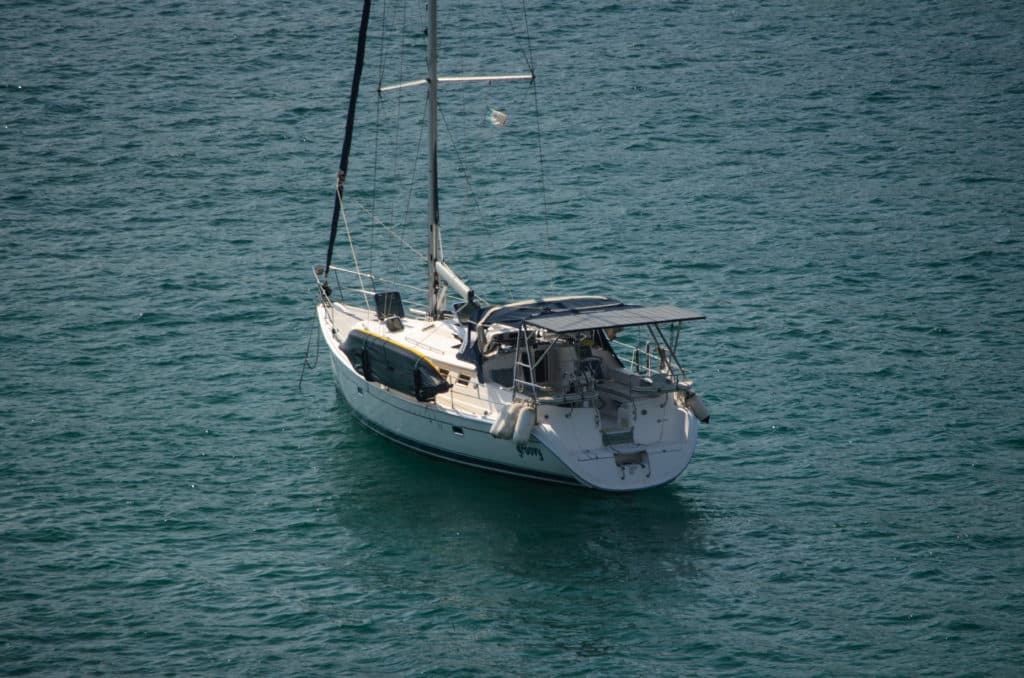
During our nearly four-year cruise of Mexico, my husband, Mark, and I lived almost exclusively on 555 watts of solar power charging a 640-amp-hour house battery bank. We anchored out virtually every night aboard our 2008 Hunter 44DS, Groovy , and relied on the sun for power. During one 10-week stretch, while we waited for a replacement engine alternator to arrive, our boat’s solar panels were our sole source of power. We had no backup charging system to turn to, and yet we lived and sailed comfortably the entire time. Mounting solar panels on a sailboat was not difficult, but a few key decisions made a huge difference in how effective our panels were.
A solar-power installation on a sailboat is made up of two independent systems: one system to charge the batteries, and another system to provide 120-volt AC power for household appliances. In the charging system, the solar panels convert sunlight into electrical current and deliver it to the batteries via a solar charge controller. Similar to a voltage regulator, the charge controller acts as a gatekeeper to protect the batteries from receiving more current than they need as they are being charged. In the AC power system, an inverter or inverter/charger converts the 12-volt DC power in the battery into 120 volts AC whenever it is turned on.
Panel Positioning and Wiring Considerations
One of the biggest challenges for sailors installing solar power on a sailboat is finding a place on the boat where the panels will be shaded as little as possible. Just a few square inches of shade on one panel can render that panel all but inoperable. Unfortunately, between the mast, radome, spreaders and boom, shadows cross the deck all day long, especially as the boat swings back and forth at anchor.
What’s worse, if the panels are wired in series rather than in parallel, this little bit of shade can shut down the entire solar-panel array. When we installed solar power on Groovy , we had already lived exclusively on solar power in an RV for over two years. Our RV solar panels had been wired in series, and we had witnessed the array shutting down current production when just half of one panel was shaded.
Choosing whether to wire the panels in series or parallel on a boat affects the wire gauge required, which is why many solar-power installers lean toward wiring the panels in series. Panels wired in series can be wired all the way to the solar charge controller with a thinner-gauge wire than those wired in parallel. This is because the voltage of panels wired in series is additive, while the current remains constant, so the current flowing is just that of a single panel. In contrast, the current flowing from panels that are wired in parallel is additive, while the voltage across them is not. This means that in a parallel installation, the current going to the charge controller is several times higher and requires much thicker cable to avoid any voltage loss over the length of the wire.
Not only is thinner-gauge wire less expensive, but it is also more supple and easier to work with, making the job of snaking it in and around various crevices in the boat and connecting it to the solar charge controller much less of a struggle. Thus the choice between series and parallel wiring boils down to a trade-off between system performance, expense and ease of solar system installation.
Luckily, the size of the wire can be reduced if higher-voltage solar panels are chosen. Since watts are determined by multiplying volts by amps, a higher-voltage panel that generates the same watts as a lower-voltage panel will produce less current. Therefore, selecting nominal 24-volt panels instead of 12-volt panels allows for the use of thinner wire sizes no matter how they are wired.
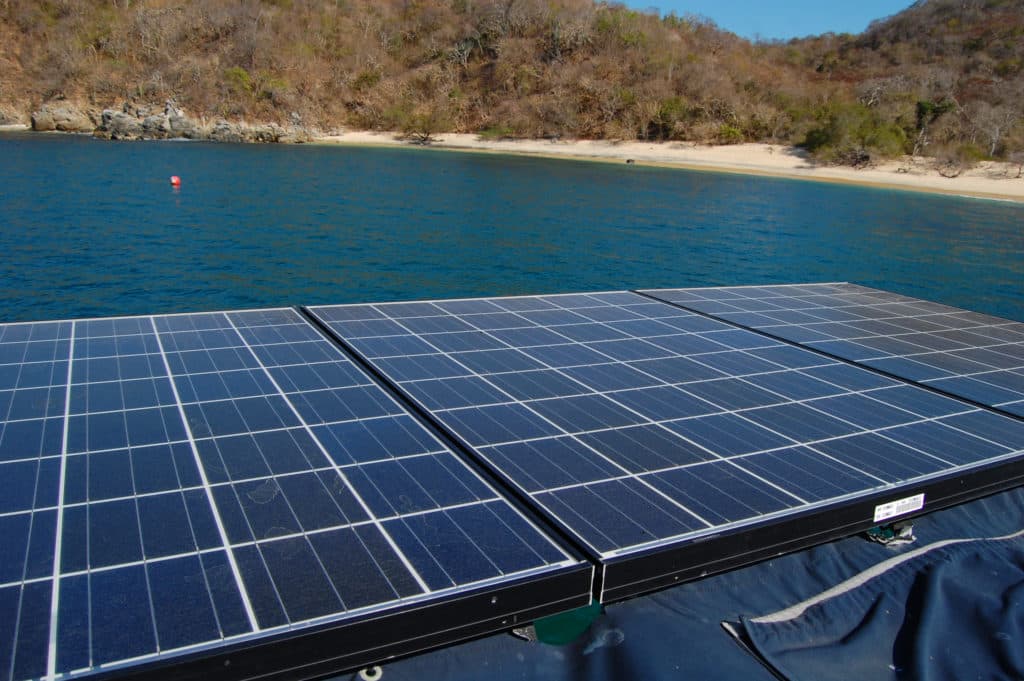
Our Marine Solar Panel Design Choices
In our installation, we decided to mount three 185-watt, 24-volt (nominal) Kyocera solar panels high above the cockpit, well aft of the boom, as far away as possible from potential shade. Our Hunter came with a big, solid stainless-steel arch, and we turned to Alejandro Ulloa, a brilliant metal fabricator at Baja Naval Boatyard in Ensenada, Mexico, to build a polished stainless-steel solar-panel arch extension onto the existing structure. He designed the arch extension with integrated telescoping davits to hoist our dinghy as well as support the solar panels. These davits were strong enough — and the lines and blocks had enough purchase — that either of us could lift our light Porta-Bote dinghy with its 6-horsepower outboard without a winch.
We spaced the panels about a half-inch apart and wired them in parallel. Using two twin-lead wires, we snaked the three positive leads and one common ground down through the inside of the arch tubes so they wouldn’t be visible, and placed wire loom over the exposed wires under the panels.
The junction points for the three parallel panels were on positive and negative bus bars inside a combiner box, all mounted in a cockpit lazarette. Inside the combiner box, we installed three breakers, one for each panel. This gave us the ability to shut off any or all of the panels if we needed to (we never did).
We mounted a Xantrex solar charge controller (model XW MPPT 60-150) in a hanging locker, as close to the batteries as possible, in a spot where it was easy to monitor and program. We ran twin-lead wire from the combiner box to the charge controller and from there to the batteries.
Our boat came with three new 12-volt Mastervolt 4D AGM house batteries, all wired in parallel, for a total of 480 amp-hours of capacity. We wanted a bigger house battery bank, and because it is best for the age, type and size of the batteries to be matched, we added a fourth new Mastervolt 4D AGM house battery, which brought our total to 640 amp-hours. Our batteries were installed at the lowest point in the hull, below the floorboards, and they ran the length of the saloon, from just forward of the companionway stairs to just aft of the V-berth stateroom door.
The best way to charge a bank of batteries that are wired in parallel is to span the entire battery bank with the leads coming from the charge controller. We did this by connecting the positive lead from the charge controller to the positive terminal of the first battery in the bank, and the negative lead from the charge controller to the negative terminal of the last battery. By spanning the entire bank, the batteries were charged equally rather than having the charging current focused on just the first battery in the bank.
We feel that AGM batteries are superior to wet cell (flooded) batteries because they can be installed in any orientation, don’t require maintenance, can’t spill (even in a capsize), and charge more quickly. Our Mastervolt batteries, like almost all AGM batteries on the market, are dual-purpose, combining the very different characteristics of both deep-cycle and start batteries. Our batteries work well, but if we were doing an installation from scratch today, we would consider the new Trojan Reliant AGM batteries. These batteries are engineered strictly for deep-cycle use and have been optimized to provide consistent current and maximize battery life.
Our boat came with a Xantrex Freedom 2,500-watt inverter/charger wired into the boat’s AC wiring system with a transfer switch. The inverter/charger performed two functions. While the boat was disconnected from shore power, it converted the batteries’ 12-volt DC power into 120-volt AC power, allowing us to operate 120-volt appliances, like our microwave. When the boat was connected to shore power, it charged the batteries.
Because this inverter/charger was a modified-sine-wave inverter, mimicking AC current with a stair-stepped square wave, we also had a 600-watt pure-sine-wave inverter to power our potentially more sensitive electronic devices. We chose Exeltech because its inverters produce an electrical signal that is clean enough to power medical equipment, and they are NASA’s choice for both the Russian and American sides of the International Space Station. For simplicity, rather than wiring the inverter into the cabin’s AC wiring, we plugged ordinary household power strips into the AC outlets on the inverter and plugged our appliances into the power strips. Like the charge controller, the inverter must be located as close to the batteries as possible. Ours was under a settee.
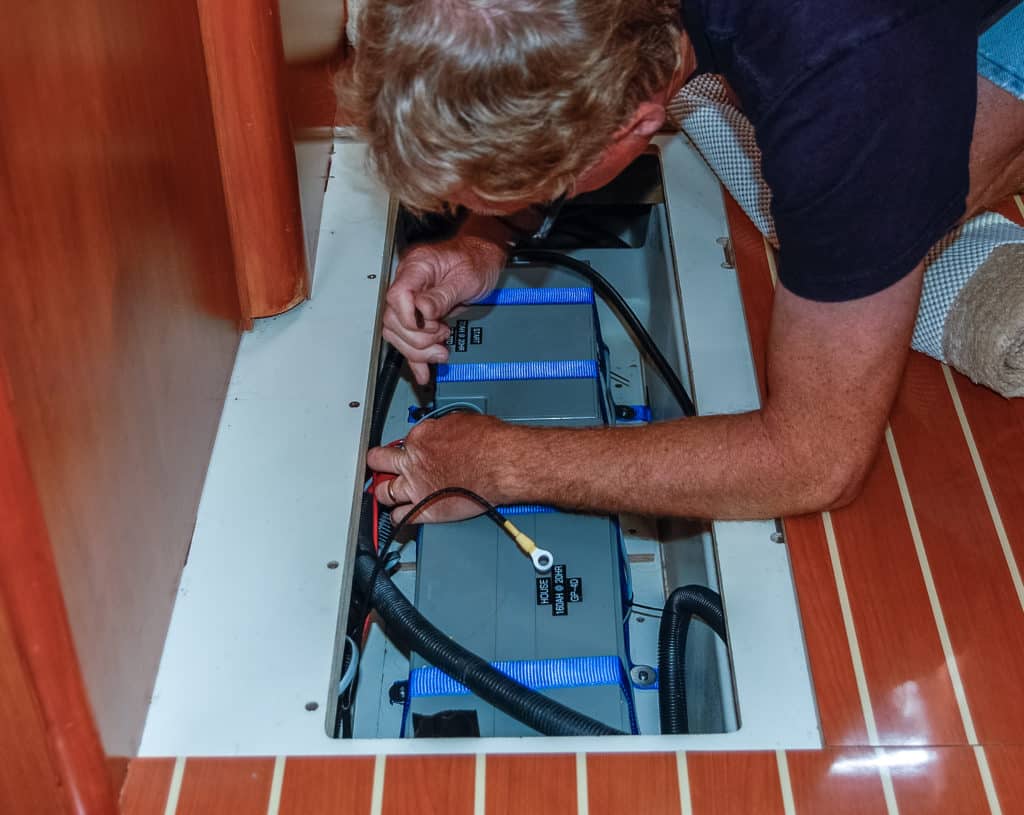
Shade’s Impact on Sailboat Solar Panels
Once our solar installation was completed on our sailboat, we closely observed the effects of shade on our solar-panel array. We were often anchored in an orientation that put the panels in full sun. Just as often, however, we were angled in such a way that shade from the mast and boom covered portions of our panels. It was fascinating to monitor the solar charge controller’s LCD display whenever the sun was forward of the beam — the current from the panels to the batteries fluctuated up and down as we swung at anchor.
Taking notes one morning, we noticed that the charging current was repeatedly creeping up and down between 9.5 and 24.5 amps as the boat moved to and fro. When the entire solar-panel array was in full sun, it generated 24.5 amps of current. When we moved so the mast shaded a portion of one panel, the array generated 15 amps. When it shaded portions of two panels and only one was in full sun, the array produced just 9.5 amps. Of course, it would have been preferable to see a steady 24.5 amps all morning, but this sure beat watching the current drop to zero whenever a shadow crossed a panel.
We discovered that shade makes a huge impact while sailing, too. Surprisingly, it is far worse to have the panels shaded by the sails than to have the panels in full sun but tilted away from its direct rays. One afternoon, we noticed that while we were on a tack that tilted the panels away from the sun, they generated 24.5 amps of current, whereas on a tack where the panels were tilted toward the sun but two of the three were partially shaded by the sails, the current dropped to a mere 10 amps.
Reflections On Our Solar Panel Installation
A wonderful and surprising side benefit of our large solar panels and arch system was that the setup created fabulous shade over the jumpseats at the stern end of the cockpit. Our metal fabricator, Alejandro, placed a support strut at hand-holding height, and sitting in those seats feels secure and comfortable while sailing, no matter the conditions.
After living on solar power for eight years of cruising and land-yacht travel, we’ve learned that you can never have too much solar power. Groovy’s 555 watts was enough to run all our household appliances as needed, including our nearly 4-cubic-foot DC refrigerator, two laptops, a TV/DVD player, and lights at night. However, it was not quite enough power to run all that plus our stand-alone 2.5-cubic-foot DC freezer during the short days and low sun angles of the winter months without supplemental charging from the engine alternator every few days. For the 10 weeks that we did not have a functioning alternator, our solution was to turn off the freezer, which enabled our batteries to reach full charge every afternoon.
Solar power made a world of difference in our cruise. Not only did it allow us to live comfortably and with ample electricity for weeks on end when our engine alternator went on the blink, but as a “set-it-and-forget-it” system, it also gave us the freedom to anchor out for as long as we wished without worrying about the batteries. In our eyes, the solar-panel arch enhanced the beauty and lines of our boat, giving her a sleek and clean appearance. It was true icing on the cake to discover that the panels and arch system also provided much-needed shade over the cockpit and helm from the hot tropical sunshine. If you are preparing for a cruise, consider turning to the sun for electricity and outfitting your sailboat with solar power.
The Installation:
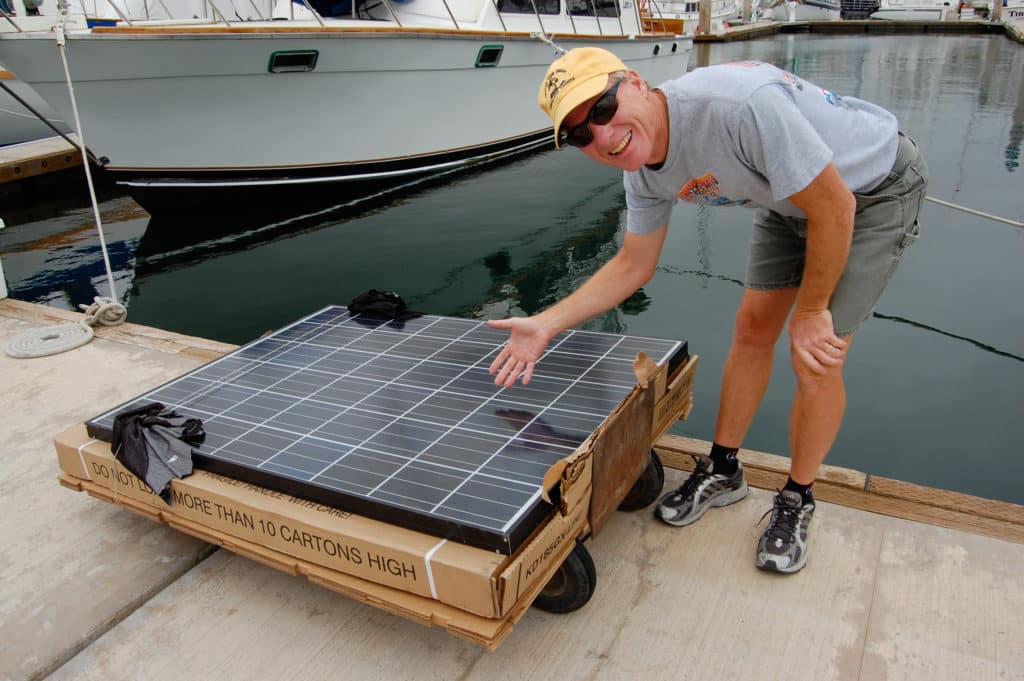
Emily and Mark Fagan offer cruising tips and share their stories and photos on their website, roadslesstraveled.us . They are currently enjoying a land cruise across America aboard an RV.
- More: DIY Sailboat Projects , green sailing , How To , installations , Refits , Sail Green , solar , solar panel , Upgrades
- More How To

Surviving the Storm: A Sailor’s Tale of Hurricane Lee

Best Practices for Boat-Show Shopping

Grease the Wheels of Your Boat: A Guide to Proper Lubrication

A Bowsprit Reborn: A DIY Renovation Story

Savoring Superior: A Great Lakes Cruise To Remember

Point Your Compass Due South, Bitter End Yacht Club Reopens October 23rd.
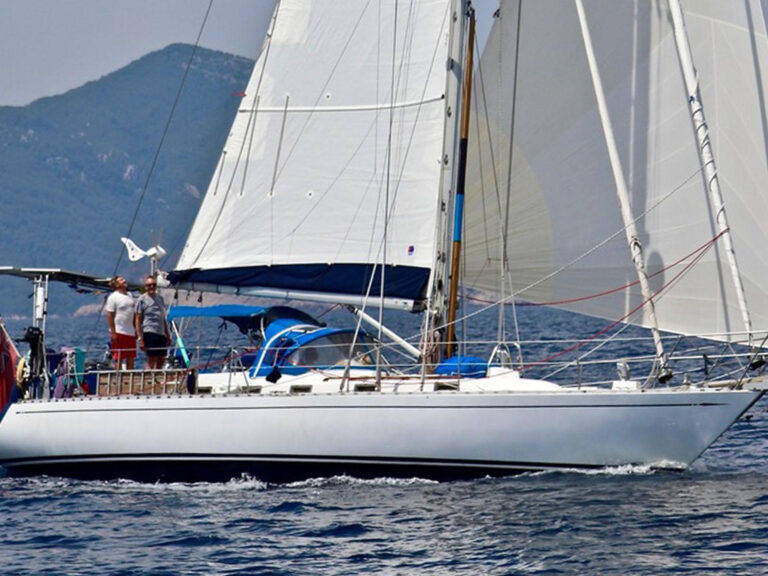
Pre-Owned: 1988 Hylas 47
- Digital Edition
- Customer Service
- Privacy Policy
- Terms of Use
- Email Newsletters
- Cruising World
- Sailing World
- Salt Water Sportsman
- Sport Fishing
- Wakeboarding

Please verify you are a human
Access to this page has been denied because we believe you are using automation tools to browse the website.
This may happen as a result of the following:
- Javascript is disabled or blocked by an extension (ad blockers for example)
- Your browser does not support cookies
Please make sure that Javascript and cookies are enabled on your browser and that you are not blocking them from loading.
Reference ID: 5a94d793-755d-11ef-beb0-5f3576c61dd9
Powered by PerimeterX , Inc.
- Lithium Golf Cart Batteries
- Lithium Trolling Motor Batteries
- Lithium RV Van Batteries
- 12V LiFePO4 Series
- 24V LiFePO4 Series
- 48V LiFePO4 Series
- Lithium Battery Chargers
Recent Post
12 September 2024
10 September 2024
09 September 2024
[Full Guide] What is a Solar Battery Charger for Boats

In recent years, the marine industry has seen a significant shift towards sustainable and eco-friendly practices. One of the most innovative solutions to emerge from this trend is the solar battery charger for boats. As boaters become more conscious of their environmental impact and seek to reduce their reliance on traditional power sources, solar battery chargers have gained popularity as a reliable and efficient way to keep boat batteries charged while out on the water.
Understanding Solar Battery Chargers for Boats
A solar battery charger for boats is a device that harnesses the power of the sun to generate electricity, which is then used to charge the boat's batteries. These chargers typically consist of photovoltaic (PV) panels, which convert sunlight into electrical energy, and a charge controller to regulate the charging process and protect the batteries from overcharging.
Types of Boat Solar Battery Chargers
There are several types of solar battery chargers available, each designed to meet specific needs and applications. Understanding the different types can help individuals choose the most suitable charger for their specific requirements. Here are some common types of solar battery chargers:
Portable Solar Battery Chargers:
Portable solar battery chargers are lightweight and designed for easy transportation. They are ideal for outdoor activities such as camping, hiking, and boating. These chargers often feature foldable or flexible solar panels, making them easy to pack and carry. They are typically used to charge small electronics, such as smartphones, cameras, and portable power banks.
Fixed Solar Battery Chargers:
Fixed solar battery chargers are designed for permanent installation on boats, RVs, and other vehicles. These chargers are mounted in a fixed location and are often integrated into the vehicle's electrical system. Fixed solar chargers come in various sizes and configurations, allowing them to accommodate different power requirements.
Maintainer Solar Battery Chargers:
Maintainer solar battery chargers are designed to keep batteries at a fully charged state and prevent them from discharging when not in use. These chargers are commonly used for maintaining the charge of vehicle batteries, including those in boats, motorcycles, and classic cars. They are particularly useful during long periods of storage or when the vehicle is not in regular use.
Folding Solar Panels with Built-in Charge Controllers:
Some solar battery chargers come in the form of folding solar panels with integrated charge controllers. These panels are versatile and can be easily adjusted to capture sunlight from various angles. The built-in charge controller helps regulate the charging process, making them suitable for charging a wide range of batteries, including those used in boats and RVs.
Solar Trickle Chargers:
Solar trickle chargers are designed to slowly charge a battery over an extended period. They are particularly useful for maintaining the charge of batteries in vehicles that are infrequently used, such as boats, classic cars, or seasonal recreational vehicles. Solar trickle chargers are often compact and easy to install, making them a convenient choice for maintaining battery health.
Solar-Powered Battery Banks:
Solar-powered battery banks are larger-scale systems that consist of multiple solar panels and a bank of batteries. These systems are designed to store a significant amount of energy for later use. They are commonly used in off-grid applications, such as remote cabins, marine vessels, and RVs, where a reliable and sustainable power source is essential.
Each type of solar battery charger offers unique features and benefits, catering to different power requirements and usage scenarios. When choosing a solar battery charger, it's important to consider factors such as power output, size, mounting options, and compatibility with the specific type of battery being charged.
Benefits of Solar Battery Chargers for Boats
Eco-friendly power source.
One of the primary advantages of using a solar battery charger for boats is its eco-friendly nature. By utilizing clean, renewable energy from the sun, boaters can significantly reduce their carbon footprint and minimize their impact on the environment.
Cost-Effective Solution
While the initial investment in a solar battery charger may be higher than traditional chargers, the long-term cost savings are substantial. Once installed, solar chargers require minimal maintenance and can provide a reliable source of power without the ongoing expense of fuel or electricity.
Independence from Shore Power
Boaters can enjoy greater independence and flexibility by using solar battery chargers. With the ability to harness solar energy, boaters are no longer solely reliant on shore power or the boat's engine to keep their batteries charged, allowing for more extended periods of off-grid cruising.
Quiet and Low-Maintenance Operation
Solar battery chargers operate silently and have few moving parts, resulting in minimal maintenance requirements. This makes them an attractive option for boaters who value peace and tranquility while on the water.
How Solar Boat Battery Chargers Work
A solar boat battery charger consists of three essential components: solar panels, a charge controller , and wiring. The process begins with the solar panels, which capture energy from the sun and convert it into electricity. However, the electricity generated by the solar panels is not inherently suitable for directly charging batteries, as it may not be properly conditioned and could potentially damage the batteries if connected directly.
To address this issue, a vital component of the solar charging system is the solar charge controller. This device plays a crucial role in ensuring safe charging conditions by regulating the current and voltage flowing from the solar panels to the batteries. By monitoring and controlling the charging process, the charge controller safeguards the batteries from overcharging, undercharging, and other potential issues, thereby extending their lifespan and optimizing their performance.
In addition to the solar panels and charge controller, the solar battery charging system also includes wiring and fuses, which serve to interconnect the solar panels, charge controller, and batteries. Properly installed wiring and fuses are essential for the safe and efficient operation of the solar charging system, ensuring that electricity is transmitted effectively while protecting the components from potential electrical hazards.
MPPT vs PWM Battery Charging for Boats
When it comes to solar battery charging for boats, two common technologies used in charge controllers are Maximum Power Point Tracking (MPPT) and Pulse Width Modulation (PWM). Each technology offers distinct advantages and considerations for marine applications.
MPPT (Maximum Power Point Tracking)
MPPT charge controllers are known for their ability to maximize the efficiency of solar panels by continuously adjusting the electrical operating point to ensure that the panels are operating at their maximum power output. This technology is particularly advantageous in situations where there are fluctuations in solar irradiance and temperature, as it can adapt to varying environmental conditions, ultimately leading to higher energy harvest and improved charging efficiency.
In marine environments, where sunlight and weather conditions can change rapidly, MPPT charge controllers are often preferred for their ability to optimize energy capture from the solar panels, making them well-suited for boats and other marine vessels.
PWM (Pulse Width Modulation)
PWM charge controllers are another common technology used in solar battery charging systems. Unlike MPPT controllers, PWM controllers maintain a fixed voltage output, which can result in slightly lower efficiency compared to MPPT controllers, especially under varying environmental conditions. However, PWM controllers are often simpler in design and can be a cost-effective option for smaller solar charging systems.
In marine applications, PWM charge controllers can still provide reliable performance, especially in scenarios where the solar panel array is relatively small and the environmental conditions are relatively stable.
When selecting a solar battery charger for a boat, understanding the differences between MPPT and PWM charge controllers is crucial for choosing the most suitable technology based on the specific requirements and conditions of the marine environment. By considering factors such as solar panel configuration, environmental variability, and power demands, boat owners can make informed decisions about which type of charge controller best meets their needs for efficient and reliable solar battery charging.
Read on MPPT VS PWM for more information about the comprehensive comparision.
Should You Leave a Boat Battery Charger Plugged In All The Time?
Leaving a boat battery charger plugged in all the time can be both beneficial and potentially risky, depending on the type of charger and the specific circumstances. Here are some considerations to keep in mind:
Automatic Maintenance Chargers: Some modern boat battery chargers are designed to function as automatic maintenance chargers. These chargers are equipped with features such as float mode or trickle charging, which allow them to maintain the battery at an optimal charge level without overcharging. In such cases, leaving the charger plugged in all the time can help ensure that the boat's battery remains in good condition, especially during periods of inactivity.
Manual Chargers: If the charger does not have automatic maintenance features and operates in a continuous charging mode, leaving it plugged in all the time can lead to overcharging, which can damage the battery over the long term. Overcharging can cause electrolyte loss, excessive heat, and accelerated plate corrosion, ultimately reducing the lifespan of the battery.
Environmental Considerations: Environmental factors such as temperature and humidity can also affect the decision to leave a boat battery charger plugged in. In extremely hot or humid conditions, continuous charging can lead to excessive gassing and water loss in flooded lead-acid batteries, potentially causing damage.
Safety Concerns: There are also safety concerns associated with leaving a charger plugged in all the time. If the charger malfunctions or if there is a power surge or electrical issue, leaving the charger connected could pose a fire hazard.
Given these considerations, here are some best practices for leaving a boat battery charger plugged in:
Automatic Maintenance Chargers: If the charger has automatic maintenance features, leaving it plugged in during periods of inactivity can help keep the battery in good condition. However, it's still a good idea to periodically check the battery's water level and overall condition.
Manual Chargers: For manual chargers without automatic maintenance features, it's generally advisable to disconnect the charger once the battery is fully charged to prevent overcharging. If the boat is not in regular use, periodic charging sessions to maintain the battery's charge level may be sufficient.
Safety Precautions: Regardless of the type of charger, it's important to follow the manufacturer's guidelines and safety recommendations. This includes using a charger appropriate for the type of battery, ensuring proper ventilation, and monitoring the charging process for any signs of malfunction.
In summary, the decision to leave a boat battery charger plugged in all the time depends on the type of charger, the condition of the battery, and environmental factors. It's important to weigh the benefits of maintaining the battery's charge against the potential risks of overcharging and safety concerns.
What Size Solar Panel Do You Need To Charge Your Boat Battery?
The solar panel size is determined by your power requirements. For a liveaboard boat with significant household appliances, a higher wattage system is necessary. Conversely, if you're maintaining a battery for minimal use, such as radios and lights, a smaller system suffices.
Additionally, factors such as sunlight exposure, seasonal changes, and your location affect the power generation. While it varies, a general estimate is that a 100-watt solar panel typically produces around 350 watt-hours per day.
Your solar system size should also account for your battery capacity. If you have a large battery bank and anticipate significant power usage at night, your solar setup should be sufficient to recharge the battery bank and fulfill your daytime energy requirements.
Related reading: How to Charge Trolling Motor While on the Lake?
As the marine industry continues to embrace sustainable practices, the adoption of solar battery chargers for boats is poised to grow. With their environmental benefits, cost savings, and independence from traditional power sources like lithium batteries , solar battery chargers offer a compelling solution for boaters seeking to reduce their environmental impact and enhance their on-water experience.
In conclusion, a solar battery charger for boats represents a significant advancement in marine technology, offering boaters a sustainable, cost-effective, and reliable way to keep their batteries charged while enjoying the open water.
Upgrade Your Boat Battery to Lithium for Better Performance
Enhance your boat's electrical performance by upgrading to a lithium-ion battery, which offers numerous advantages over traditional lead-acid batteries. With higher energy density, a longer lifespan, faster charging capabilities, consistent voltage output, maintenance-free operation, and lighter weight, lithium batteries provide a reliable and efficient power source for your boat.
Visit LiTime Marine Boat Sereis to choose the ideal battery.

RELATED POSTS
Difference between 48v and 51.2v golf cart batteries, mppt inverter vs. charge controller: understand the key differences, is a car battery ac or dc understanding the basics.
- user Account
- Cart 0 0 items
- Choosing a selection results in a full page refresh.
Thanks for subscribing! A 5% new user discount code has been sent to your email.
This email has been registered!
Shop the look
Trending search.
- 12v 100ah mini
- 12V battery
- 24V battery
- 36V battery
- 48V battery
- trolling motor battery
- 12V 100Ah TM
- 12V 100 Group 24 Bluetooth
- battery monitor
- battery box
Best Sellers
Choose options.
- Facebook Facebook
- Instagram Instagram
- Pinterest Pinterest
- YouTube YouTube
Edit Option

- Multihull Sailor
- Real Estate
- Maintenance & Hardware
- Water Sports
The Best Solar Panels for Boats for Eco-Friendly Energy
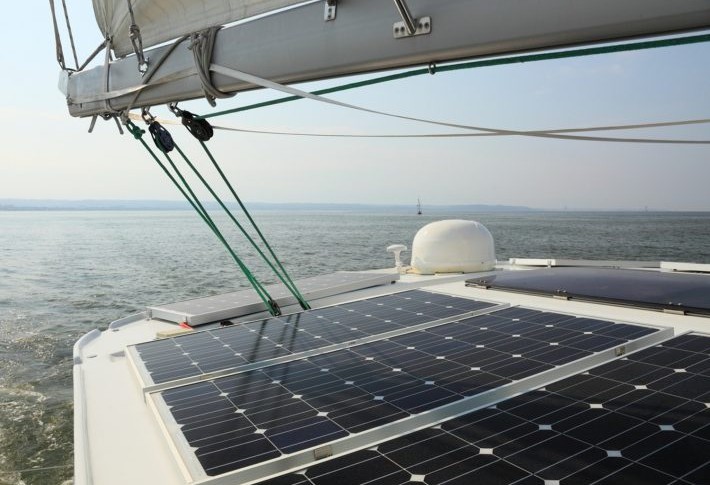
Solar energy is the most abundant renewable energy source. Harnessing the sun's power is a reliable and eco-friendly way to power your boat and get where you want to go. It’s also a great backup energy source during an emergency. You can save money and reduce pollution—it's a win-win!
Solar panels are a great way to give your boat energy and power. The Renogy Solar Panels for Boats (our favorite) has panels that are compact, reliable, and built to last with corrosion-resistant aluminum frames and low-iron-tempered glass. Keep reading and learn which solar panel is right for your boat!
Our Top Picks For Solar Panels for Boats
- Best Overall: Renogy Solar Panels for Boats Shop Now ➔
- Largest Panels: Rophie Solar Panels for Boats Shop Now ➔
- Most Durable: TopSolar Solar Panels for Boats Shop Now ➔
- Most Lightweight: ECO-WORTHY Solar Panels for Boats Shop Now ➔
- Easiest Installation: Sunway Solar Panels for Boats Shop Now ➔
- Most Surface Area: EF ECOFLOW Solar Panels for Boats Shop Now ➔
- 1 What to Consider When Buying Solar Panels?
- 4 Accessories
- 5 How Do Solar Panels for Boats Work?
- 6 Installation
- 7 What Are Care Requirements to Enhance the Life of Solar Panels for Boats?
- 9 Cleaning
- 10 What Are the Properties of Charge Controllers for Solar Panels for Boats?
- 11 Basic charge controllers
- 12 Mid-range charge controllers
- 13 Max power charge controllers
- 14 Conclusion
Can solar panels for boats run a trolling boat motor?
How long does it take for a solar panel to charge your boat’s battery, why do people consider installing solar panels for boats, related articles, the best solar panels for boats, best overall.

Renogy Solar Panels for Boats
The Renogy are 100W monocrystalline solar panels providing an average of 400-500Wh or 33-41Ah of electricity per day, so you have reliable performance. It has bypass diodes that protect the solar cells from overheating, so you don’t have to worry about maintenance. In addition, it features a corrosion-resistant aluminum train providing extended outdoor use without any extra damage.
These solar panels come with pre-drilled holes on the back so that you can install and mount them without spending money on professional help. They measure 42.2 x 19.6 x 1.38 inches and weigh 14.3 pounds, making them lightweight and convenient. Moreover, you can install them on boats, rooftops, cabins, and more for multifunctional use. Because of their efficiency and reliability, these solar panels stand at the top of our list.
- They are weather-resistant
- These solar panels maintain cell temperature
- Provide reliable performance
- Only compatible with Renogy ground mounts and brackets
Largest Panels
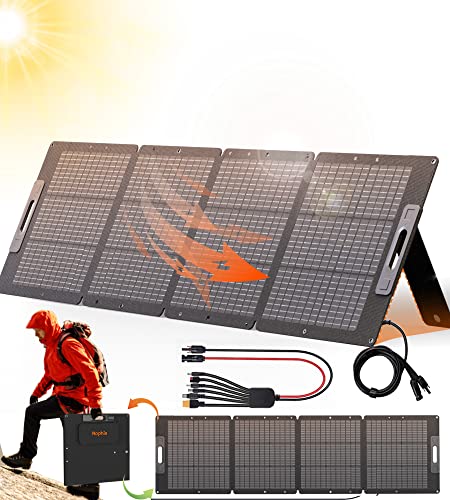
Rophie Solar Panels for Boats
The Rophie Solar Panels easily stands out on this list. Designed with impeccable efficiency, they accelerate solar charging to the next level, making it ideal for outdoor enthusiasts and off-grid boat owners. These solar panels convert sunlight into power rapidly, while their ultra-light, foldable design ensures convenience during transport and installation. Don’t let their light weight fool you, though, as they pack an impressive 200 watts, delivering unmatched power performance for your boat or outdoor camping.
These panels don’t just excel in efficiency and power; they’re also built to endure. Their IP67 waterproof grading ensures that they remain operational even under challenging weather conditions. Their high-quality MC-4 connectors further optimize power transfer while ensuring safe and secure connections. Plus, their compact design won’t take up much space, proving to be the optimal choice for boat owners who value both power and convenience.
- Lightweight and easily transportable
- Durable and water-resistant
- High-performance with 200W
- Can be a little pricey
Most Durable

TopSolar Solar Panels for Boats
The TopSolar Solar Panels are available in a kit containing 20W solar panels, a solar charger regulator of 12V/24V, two 6.5-foot cables with alligator clips, and an O-ring terminal to have a complete experience while on the go. They are perfect for off-grid 12-volt battery charging systems providing you with various DC applications like cabins, boats, battery-operated gates, and more. They come with a 10A solar charger controller preventing the battery from overcharging, discharging, and risk of short circuit for a safe experience.
These solar panels have aluminum and tempered glass frames, ensuring a durable and weather-resistant use. Weighing 2.75 pounds and measuring 2.32 x 13.86 x 17.13 inches, they are compact and portable.
- Easy to store and carry
- They come in a complete kit
- Provide excellent weather resistance
- Not suitable for large areas and machinery
Most Lightweight

ECO-WORTHY Solar Panels for Boats
The Eco-Worthy Solar Panels are 10W 12V solar car battery chargers that can be used to recharge boats, motorcycles, boats, snowmobiles, and tractors. They feature a cigarette plug option supplying you with constant power when needed. This kit includes a cigarette lighter adapter, one pair of battery clips, and four-piece PVC suckers ensuring maximum results in no time.
They also have energy-saving, built-in blocking diodes that prevent reverse discharge from maintaining and extending battery life for maximum durability. It measures 1.4 x 9.6 x 15.3 inches and weighs only 1.5 pounds, so you have a compact product at hand
- They are available in a complete kit
- These panels are lightweight and compact
- They can recharge different types of vehicles
- Longer charging times
Easiest Installation

Sunway Solar Panels for Boats
The Sunway Solar Panels are battery charger panel mounts that require a simple installation on any windshield or dash, giving you a quick and convenient experience. They come with 12-volt batteries and a maintainer that protect your panels from overheating and discharging, ensuring safe and convenient use. In addition, these panels are equipped with ultra-clear PC glass, so you have a strong and durable product.
They contain built-in blocking diodes that prevent reverse charging allowing your battery to maintain its useful life. Moreover, they also come with a blinking LED charge indicator that lets you know when the job is done.
- Comes with a battery maintainer
- Do not require professional installation
- Comes with charging indicators
- Suitable to recharge small batteries only
Most Surface Area

EF ECOFLOW Solar Panels for Boats
The EF Ecoflow provides 160W foldable solar panels are designed to produce maximum power at any time of the day when paired with an EcoFlow power station, so you never run out of electricity. Moreover, they have a seamless one-piece waterproof design, so you can use them during outdoor activities like camping and hiking.
These solar panels are also equipped with protection during transportation, enabling you to carry them without any concerns. Each pack comes with an Ecoflow 160W solar panel, kickstand case, user manual, and warranty card, so you don’t have to make any additional purchases.
- They can be folded for easy storage
- Comes in a complete kit
- Suitable for different outdoor activities
- Can only be paired with an Ecoflow power station
The Best Solar Panels for Boats Buying Guide
What to consider when buying solar panels .
Since solar panels are an expensive addition to your asset list, here are a couple of essentials to remember when purchasing.
The size of panels is directly related to the size of your boat. You must get something to match the energy requirements of your boat or greater. A solar panel too small might not power it and leave you frustrated. Other than this, smaller products have less battery time which means they will turn off much quicker than something explicitly designed for the size of your boat.
From PVC to glass covering and fully flexible panels, the type you choose determines their cost. This helps you establish your budget according to your needs. A glass-fronted solar panel is among the most budget-friendly options, but they are not as weather resistant. Besides this, a polycarbonate version is more expensive, but they are incredibly weather resistant and have a longer life.
Accessories
A charge controller or maintainer is an essential component available for your boat’s solar panels. This product protects your panels from battery damage. They prevent any risk of overheating, battery discharge, or sudden drops. A charge controller is essential if you want to elongate the battery’s life. Most brands also offer mount brackets, so you don’t have to purchase them separately.
How Do Solar Panels for Boats Work?
Solar panels for boats work just like any other portable energy provider. To install it successfully, you must have four components: the solar panel itself, charge controller, inverter, and battery. When solar panels in the boat hit sunlight, they convert it into the electrical current, supplying your boat with the required energy.
Boat solar panels can work without a charger maintainer (controller), but there is a risk of overcharging your device. Therefore, you must keep it in place to avoid any risk of battery damage.
The need for an inverter depends on the number of appliances that need a charge. For instance, if you wish to charge multiple devices other than the boat, consider buying a large-capacity product.
You can opt for professional installation if offered by the brand or any other reputed company. But individuals who have the basics can do it all by themselves. However, you must make sure that all the relevant accessories are available at your convenience.
Installation
The installation method is divided into three main stages. The first stage is to conduct an energy assessment. In this, you will determine the level of energy that your boat needs to function. Buy a panel that has a higher voltage than your requirements. This gives more room and flexibility to charge other devices.
Check whether the solar panel can produce that level of energy. Once the capacity is determined, you can decide the exterior of your panels. In most cases, you choose between glass-fronted, polycarbonate, and fully flexible panels.
What Are Care Requirements to Enhance the Life of Solar Panels for Boats?
Caring for solar panels is essential as they are a long-term investment and should last accordingly.
Most solar panels are designed to last two to three decades. Caring for them is fairly simple but requires regular attention. All you have to do is keep them clean from dirt, leaves, and other obstructions. Solar panels from reputable brands always come with a warranty for a couple of years.
Always get a professional repair from the brand in case of any damage. Even if your warranty has expired, we recommend taking your boat’s solar panels to a professional. They might cost a bit more than a local mechanic, but your panels get the treatment they require.
Another factor to consider here is the useful life of your solar panel. This indicates that they will not be as effective as they age. The depreciation in their quality is slow and gradual.
If your product has met the end of its useful life, it won’t stop working but will get more prone to damage. So instead of getting frustrated with why your solar panel for boats isn’t working properly, consider getting a replacement from the same brand or changing your product.
To clean a solar panel, use lukewarm water with a mild, non-acidic detergent and apply water pressure to remove any visible dirt and debris. Panels for boats are relatively smaller, so you won’t need a lot of supply. Clean any unwanted spots with a damp cloth and leave it to dry. Avoid applying water pressure on smaller models as they might not sustain the burden.
What Are the Properties of Charge Controllers for Solar Panels for Boats?
Charge controllers are an essential component. They help protect your panels’ battery from damage. There are three main types of charge controllers available.
Basic charge controllers
They use pulse width modulation to encode transmission information allowing control of the power supplied to boats or other devices. These are simple chargers that come in at an affordable price range. A primary charge controller is designed to control batteries of smaller solar panels. They might not deliver desirable results if connected with a high-capacity panel.
Mid-range charge controllers
These controllers also use pulse width modulation but feature an LCD display to indicate current charging levels. This helps the user keep track of the system and unplug the device when it’s ready to use.
Max power charge controllers
Designed for high-end and powerful solar panels, they are one of the most expensive charge controllers. You should only attach them to devices recommended by the brand itself. They also maximize the performance of panels.
Conclusion
Solar panels are a great way to maximize energy efficiency in your boat and create a durable backup. They are available in different sizes and capacities, so you can find a suitable fit for your boat. This article carefully reviewed the most in-demand solar panels for boats in 2024 that can make a difference in your overall experience. Besides the panel, you should also grab a top-notch charge controller that protects the device from damage and enhances its life.
People Also Asked
Yes, you can run a trolling motor with solar panels, but it is essential to opt for a device that has suitable capacity.
If the panel is according to the desired capacity of the boat, it might take 4 to 6 hours for a full charge.
Solar panels reduce carbon emissions and save money by reducing fuel costs. They also reduce the noise levels caused by a fuel-ignited engine.
Article Contributors
Sail magazine review team.
SAIL Magazine Review Team reports on best-selling products in sailing and boating. SAIL Magazine is reader-supported: When you buy through links on our site, we may earn an affiliate commission. Artificial Intelligence (large language models) may have been used in the research and creation of the content.
To ensure questions about product testing or a specific article are addressed, please contact [email protected]

- Solar Dock Lights
- Boat Lift Motors
- Boat Lift Solar Charging Kits
- Trolling Motor Solar Charging Kits
- Solar Buoys & Nav. Lights
- Solar Boat House, Gazebo & Pergola Lights
- Store Locator
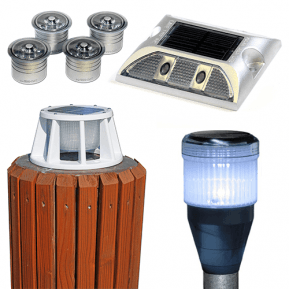
- Dual Wake Boat Battery Solar Charging Kits
Boat Battery Solar Charging Kits
- Solar Panels & Wiring Kits
- Solar Panel Mounting Arms
- Trolling Motor Solar Charging Kits →
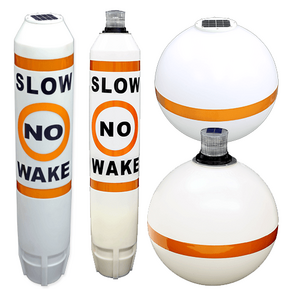
- Solar Dock Lighting

- Charging Accessories

- Boat Lift Accessories

- Boat Battery Solar Charging Kits & Accessories

- Solar Buoy Lights

- Jul 27, 2019
What charger do you recommend for a Dehawk 48v 16ah battery? Where can I buy one? I’m in the US. This is the battery used in the Moscow plus bike. My existing charger seems to have died. Thanks John
Attachments
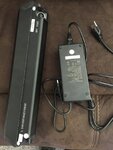
Active Member
- Aug 20, 2019
Nice links, thanks! What plug should we choose for the ncm moscow plus battery? DC, right?
Ok! I will be ordering the one with 4A, DC plug (I have checked it). Any risk of damaging the battery or anything else? any warning? I don't know much about chargers... Thanks! p.d: I did not see your message suggesting 5A after the image capture. I will think about it. Yes, NCM gave me 2A charger...
There are two models of battery for the ncm moscow plus, one with 14A and one with 16A. Mine came with 14A... will 5A be fine anyway, or should I use 4A? Thanks again!
Well-Known Member
Any risk of damaging the battery or anything else? any warning? Warning is usually SMOKE!
Mmm, true, they are Reention, but I thought they were just the same... Mine says Reention indeed.
Mmm... this opens up a new world of possibilities... can I just order a new reention battery with 16ah, 17.5ah or even 21ah from aliexpress or alibaba (I have seen them at 200$!!!) and make the switch in my bike??? That would be awesome!
- Sep 17, 2019
Decrepidude
- Mar 27, 2021
KuRi said: Ok! I will be ordering the one with 4A, DC plug (I have checked it). Any risk of damaging the battery or anything else? any warning? I don't know much about chargers... Thanks! p.d: I did not see your message suggesting 5A after the image capture. I will think about it. Yes, NCM gave me 2A charger... Click to expand...
I don't think that with 4A charge on a >13Ah battery you're in the danger zone. it's not even to close to 1C.
Similar threads
- May 23, 2024
- Maintenance and Repairs
- stonestonestone
- Jan 2, 2024
- Ask the Community Anything
- Jan 15, 2023
- May 25, 2024
- Items and Parts for Sale or Wanted, By-Owner
- Feb 6, 2024
- We use cookies to ensure that we give you the best experience on our website. Accept Learn More…

IMAGES
VIDEO
COMMENTS
The SOLPERK 50W/12V Solar Panel Kit is an excellent option for a portable solar charger for boats that features robust, waterproof construction. What we love about this product is that it was engineered to survive regular exposure to stormy conditions. The anodized aluminum frame resists corrosion, and the solar panel features waterproof ...
6. SUNER POWER 20W 12V Solar Battery Charger. The SUNER POWER 20W 12V Solar Battery Charger is a versatile and reliable solution for keeping your batteries charged up and ready to go, all thanks to the power of the sun. Whether you need to charge your boat, RV, or other 12V battery, this solar charger has got you covered.
Here is a step-by-step guide to connecting a marine solar battery charger to your boat: Selecting the Best Spot for Your Solar Battery Charger. Choose a location on your boat that receives ample sunlight throughout the day. Ensure that the area is clear of obstructions that could shade the solar panel.
4. SOLPERK 12V Solar Battery Charger and Panel. The SOLPERK 12V Solar Panel is a trickle charger. It charges and maintains 12V batteries like Wet, Gel, MF and many more. The automatic charging and maintenance controller provides protection against short circuits, open circuits, reverse and overcharging.
The following portable solar battery chargers were selected because they are perfect for boaters. While they are also enjoyed by RV drivers and camping enthusiasts, the fact that they are versatile and highly portable also makes them the perfect solar accessory for any boat owner. MaxOak - EB150 Bluetti 1,500wh Portable Solar Power Station.
THE AVAILABLE SPACE. In practical terms, a modern 40ft monohull would have the space for around 1,200W of PV panels (cockpit arch, sprayhood top, deck), maybe 1,500W with the addition of a few portable panels for use at anchor. The 1,200W of fixed position solar array could produce around 360Ah on a sunny summer's day (zero shading) or more ...
A solar battery charger is a device that uses solar energy to recharge the batteries on your boat. It works by converting sunlight into electrical energy, which is then used to replenish your battery's power. Unlike traditional battery chargers that rely on shore power or a generator, solar battery chargers harness the power of the sun to ...
Solar battery chargers use solar energy to charge your boat's batteries. This means you will have reliable and free renewable energy. It also means you don't have to rely on fuel to charge your battery, saving you money in the long run. Silent And Fuel-Free. The solar battery charger is completely silent and does not produce any greenhouse gases.
Benefits of Marine Solar Battery Chargers. Factors to Consider When Choosing a Marine Solar Battery Charger. Marine Solar Battery Charger Kit. 10 Best Solar Battery Chargers. 1. NOCO Genius GEN10X3. 2. Renogy Wanderer 100W Solar Panel Kit. 3.
That's where the SUNER POWER 20W Solar Battery Charger steps in. This portable, lightweight solar charger turns sunlight into electricity to keep your boat's battery charged and maintained all year round. The smart MPPT controller ensures efficient charging, generating 20%-30% more power than other models.
Giosolar 1,000W flexible solar panel. Best flexible boat solar panel. Delivering a mighty kilowatt of power, (not far off the amount used by a one bedroom house), this Giostar package comprises ten separate 100W panels, each of which is 1,050 x 540 x 2.5mm in size. Capable of charging either 12 or 24V batteries, a kit of this magnitude is one ...
A small solar battery charger system that consists of around 100 watts can provide enough power for small electronics, fish finders, stereos, and charging phones during the day. These systems can be used on boats with one battery or connected to a house battery bank. Small solar battery charging systems are perfect for light use on boats that ...
Jackery's solar battery chargers are high-output solar panel kits specially designed to provide maximum power output and efficiency that are sure to make your boat's living experience enjoyable. Benefits of Solar Battery Charger for Boat. Installing one or more photovoltaic solar panels on your boat is a great way to keep your appliances running.
Have also ordered a Victron Multiplus 12V 3000 watt inverter/charger, the Victron Digital Multi control, the Victron 500A SmartShunt, the Victron VE. Bus smart dongle and a Sterling 12v Alternator protection device. Hoping to add two 180 watt rigid solar panels, one 100 watt flexible panel and one 50-ish watt flexible or rigid panel.
Our boat came with a Xantrex Freedom 2,500-watt inverter/charger wired into the boat's AC wiring system with a transfer switch. The inverter/charger performed two functions. While the boat was disconnected from shore power, it converted the batteries' 12-volt DC power into 120-volt AC power, allowing us to operate 120-volt appliances, like ...
Adding a solar trickle charger to your car, RV or boat: 1 out of 10: Adding a flexible panel to charge while underway: 2 out of 10: Adding a permanent panel to the stern railing: ... Cruising and racing sailboats can use solar panels to augment or replace their other charging sources. Many sailboats that go on long passages have to use their ...
Understanding Solar Battery Chargers for Boats. A solar battery charger for boats is a device that harnesses the power of the sun to generate electricity, which is then used to charge the boat's batteries. These chargers typically consist of photovoltaic (PV) panels, which convert sunlight into electrical energy, and a charge controller to ...
The TopSolar Solar Panels are available in a kit containing 20W solar panels, a solar charger regulator of 12V/24V, two 6.5-foot cables with alligator clips, and an O-ring terminal to have a complete experience while on the go. ... Boat solar panels can work without a charger maintainer (controller), but there is a risk of overcharging your ...
I bought this battery to use with my new 200W foldable suitcase panel kit with a 20A Voyager charger. I haven't used it on a trip yet but it charged very quickly and ran things through my old inverter even unhooked from the solar charger that my 12V AGM marine/RV battery wouldn't run Unless I had it charging on the alternator From my truck.
These advanced solar charging kits, available in 12v or 24v are the perfect charge for your boat battery systems. The added power of Lake Lite's Boat Battery Solar Charging Kits ensures better performance even on cloudy days allowing for higher usage. Our high-quality solar panel will keep your boat battery in top condition, ensuring your ...
What charger do you recommend for a Dehawk 48v 16ah battery? Where can I buy one? I'm in the US. This is the battery used in the Moscow plus bike. My existing charger seems to have died. Thanks John . Attachments. C9E55A5B-35BF-43A8-9462-A34BCE3F93EC.jpeg. 107.1 KB · Views: 1,605 K. KuRi
Answer 1 of 2: Hi everyone, I am traveling to Moscow next week on Wednesday 30-01-2019, we are a big group of friends (9 person) We will be staying in a hotel close to Old Arbat (4 nights) and we are thinking of having a Cruise River Boat. So is there...
Radio Moscow: circa 1968. February 11, 2014. Many thanks to David Firth, who is kindly sharing shortwave radio recordings he made on his reel-to-reel recording equipment in the late 1960's. Firth is uncovering and digitizing these recordings as time allows. We are grateful for this recording of Radio Moscow, which Firth recorded in 1968.